Member-only story

Issue 31: SCOTT Foil: Smart and Fast
Bike Hugger Magazine
Head down and pedaling towards Lahaina, pushing air out of the way with broad shoulders and chest, the biggest gust I’ve been hit with stopped the bike for a millisecond. Thrown sideways, I corrected with a hard lean and once the bike was going straight down the road again, realized how well it handled the turbulence. In a sweet spot of leeward and windward, a tail and head wind, the bike sliced through the front pressure with lift from the rear.
Intent on a tourist pace during vacation, I was soft pedaling up and over a roller, and the speedometer read 17.5 mph, then 18. The Foil felt freakishly fast and while I was riding it on Maui’s roads trying to figure out why, Tour magazine awarded it best aero racebike of 2015. For the bike industry’s marketers and engineers, a Tour award is like winning Motor Trend’s Car of the Year and for the employees of SCOTT, a holiday bonus.
In terms of aerodynamics, Scott’s second generation of aero models succeeds in making a big jump: 211 watts are a good result. The new Foil is an outstanding racing bicycle because it is very good in key disciplines: It has the lowest frameset weight in the test, lots of comfort at the saddle, and it has an extremely stable ride. The distinctive handlebar-stem unit that, thanks to the right spacers, closely hugs the top tube, defines the bike’s silhouette.
Last year, here and in our magazine , I shared my first impressions of the Foil, finding it fast and compliant .
Fast and Compliant - Medium Bicycles
medium.bikehugger.com
After riding the Foil another hundred miles or so in trade winds, I agree with Tour’s award, and that’s because of the ride quality. Tour weighs their tests towards the all arounder, or as they put it the, “Best combination of aerodynamics, light weight, riding stability and suspension comfort.” However, for the aero aficionados the Scott is a really smart bike, it’s just not an “aero” bike compared to a Cervelo or Canyon. It won a prestigious award because it’s a general purpose road bike that doesn’t pretend aero isn’t important. You can read all of SCOTT’s marketing on a Foil mini site and they put hundreds of hours into R&D to find the right design combination and where to compromise.
I’ve ridden many of the aero bikes available today and where they gained speed by slipping through the air, compared to a regular road bike, they lacked stability, acceleration, or all-day comfort by being too stiff, in the wrong places. The previous-generation Foil accelerated like a racer, but the seat mast jack hammered your spine. Because the demands of a roadie are different than triathlete or time trialist — cornering, line changes, rapid acceleration and braking — it oftens feels like the front triangle isn’t connected to the rear and the bike is twisting under load. As I said in my first article about this Foil rev, compliance is the third act for carbon bikes. Scott gets theirs from a low and thin seat stay combined with a more compliant fork.
I’d occasionally detect that give over broken pavement, potholes, and transitions from grooved to smooth pavement. The rear triangle is where Scott made their design compromises. The low seatstay joint means the rear brake is placed under the bottom bracket and that results in less stopping power because the brakes aren’t braced against the structure of the stay. When you mount brakes on seatstays, pulling the brake lever moves the brake arms towards the stays. On the bottom of the chainstays, the arms move away from the stay when applied. The result is not the stopping power you’re used too. Improvements in bb-mounted brakes, like the one spec’d on the Foil, means it’s acceptable, but allow yourself more stopping time than usual.
When you consider comfort and carbon, or how manufacturers are tuning their rides, there’s a real marketing challenge. Steeped in the traditions of racing with suffering, and how a bike should hurt to go fast with aggressive fit, the narrative of the third act for this category of bike isn’t always compelling. If all bike designers used wind-tunnel data, they would design at least something semi-aero because aerodynamics actually do matter and it’s a quantifiable difference. Where Scott deserves praise and the Tour award is by making a road bike faster with aerodynamic properties. Compared to others in the Tour test, the foil is aeroesque with a tuned ride, and very attractive aesthetic.
Time-trial bikes from where aero road bikes came are focused on function over form. Everything about them is meant to propel a cyclist down the road as fast as possible, the ride quality being a secondary concern. When designers set out to make roadies go faster, they borrowed heavily from the TT discipline, and the result is bikes that suffer from the problems Scott and their competitors are trying to solve now. As it was said to me by Scott’s marketers, the Foil is like a high-performance, luxury sports car — it’s fast when you want and the rest of the time luxurious.
Now they’ve got to explain that to potential buyers. Extending the sports car analogy, the Foil is also finicky with some cumbersome bits, like an integrated cockpit, and seat mast binder. Scott developed attachment methods to bind the aero shapes together with less weight and more airflow, but with tiny bolts that seem like they might get damaged by an amateur mechanic.
Don’t expect to run your fat comfort tires on this whip either; 25 is about the largest that will fit, and that’s what roadies are demanding these days. It’s the road market Scott is after with the Foil, and as diehard roadie myself, I thoroughly enjoyed my second time with it and expect others will too. The Foil is very smartly designed.
The Foil I rode was the Team Issue and retails for $7,349.99. Ed. note: After a good run of 42 issues, our magazine app is no longer available, but we’ve archived the content here for Medium members.

Written by Byron
Blogger, Designer, Inventor and Publisher of www.bikehugger.com .
More from Byron and Bike Hugger Magazine
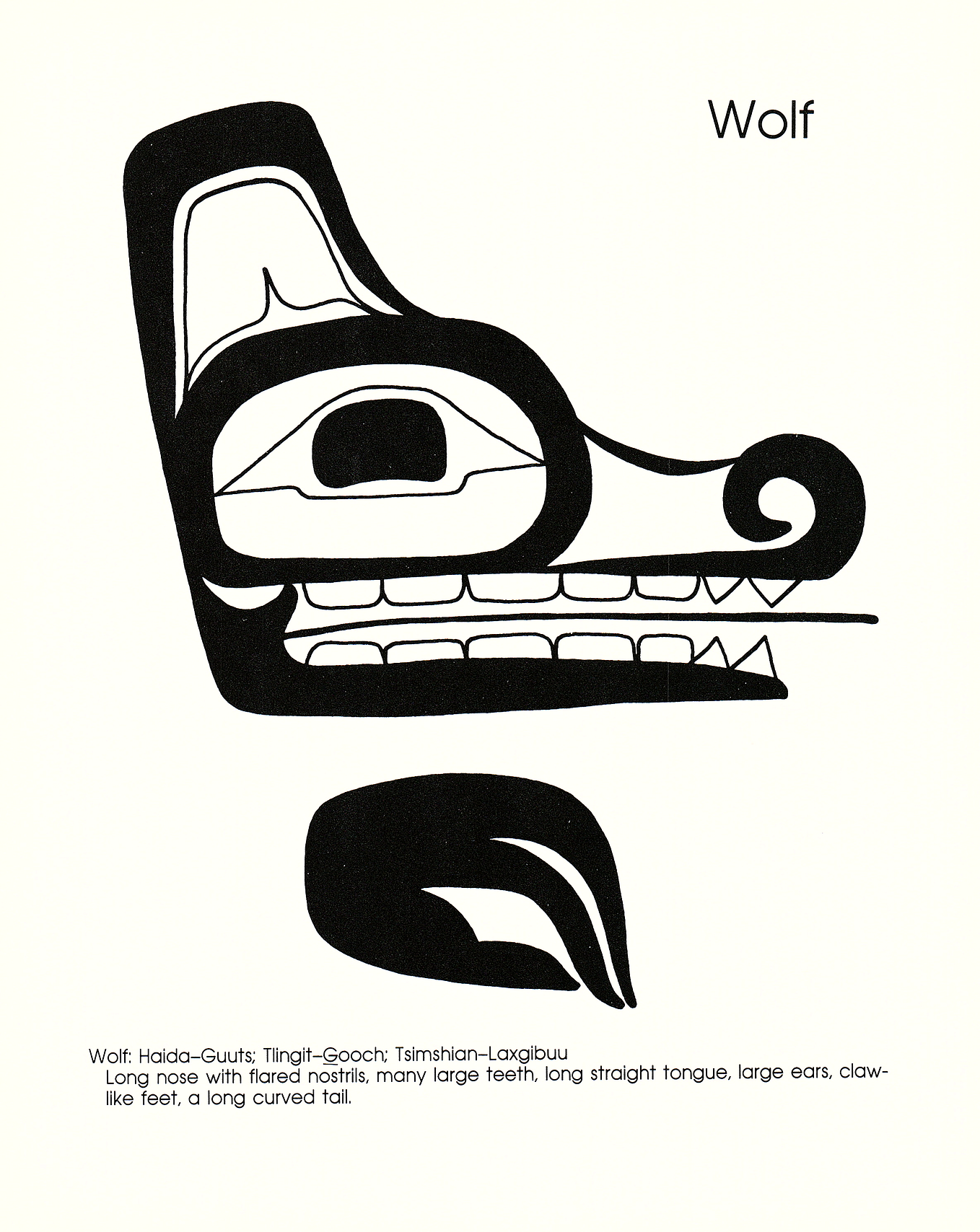
Northwest Coast Indian Art
The raven and the wolf.

Sony Kando Trip 1.0
Every sony launch i’ve attended, the president of their north american operations has mentioned kando and each time with a little more….

Issue 22: That Tomac Sound
Never saw hendrix live, but i did see tomac….

Leica Q2 Monochrom
Dedicated to black and white photography, recommended from medium.

Karolina Kozmana
Common side effects of not drinking
By rejecting alcohol, you reject something very human, an extra limb that we have collectively grown to deal with reality and with each….
Ossiana Tepfenhart
Korea’s Shocking Incel Problem Is So Much Worse Than You Think
No, for real, this is terrifying..
Best of The Writing Cooperative
Staff Picks
Write A Catalyst
I Lost 30 lbs After Healing My Gut By Quitting These 4 Inflammatory Foods.
You can’t lose weight against a sick gut..

Alexander Nguyen
Level Up Coding
The resume that got a software engineer a $300,000 job at Google.
1-page. well-formatted..

Michal Malewicz
Ugly websites sell better.
Web design is getting out of hand again..
Michelle Teheux
Minds Without Borders
We Could Learn a Lot About Sex From the Dutch
My dutch relative’s views shocked me, but i immediately realized she was right.
Text to speech
- MAGAZINE OFFERS
- BIKE INSURANCE
- Best Products
- Maintenance
- Accessories
- Long-Term Reviews
- First Look Friday
- Bike of the Week
- Tech Features
- Routes and Rides
- Bike Galleries
- BikeRadar Bargains
- Buyer's Guides
- Fitness & Training
- Sizing & Fit
- Mountain Biking UK
- Cycling Plus
- BikeRadar Podcast
Scott Foil – First ride review
Fast and free from compromise
Warren Rossiter
Jamie Wilkins
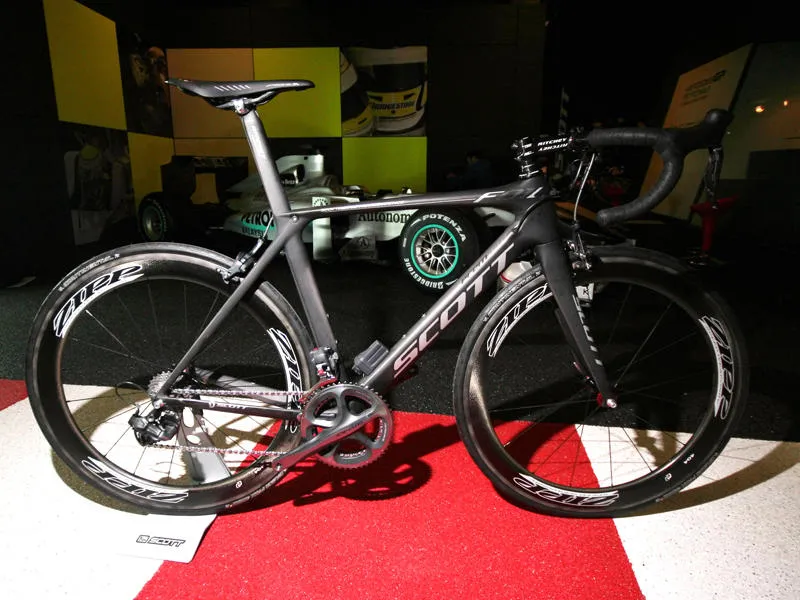
The Scott Foil is one of the most eagerly awaited bikes of the year. Prototypes were first seen at the 2010 Tour de France , but when Specialized launched the Venge a month ago Scott were almost foiled before they’d started.
The original project was codenamed F01. Scott have since found an L down the back of the sofa and the production bike is called the Foil, as in airfoil. The top tube graphic still says F01L, though, which looks like a fencer’s personalised numberplate. That aside, it’s a great looking bike – more so than in pictures.
We managed to wrangle a ride on aerodynamicist Simon Smart's bike. The spec was similar to the top-end (€9,500) Foil Premium production model (pictured), with Shimano Dura-Ace Di2. Differences included prototype ENVE Composites wheels instead of Zipp 404s, and an SRM power meter.
Ride & handling: Fast and free from compromise
It’s almost impossible to gauge a bike’s aerodynamics by feel – there are far too many variables involved – but this is definitely a fast bike. It’s stiff too, with no sensation of flex even when sprinting up short climbs out of the saddle and pulling hard on the drops.
We rode the Scott in Lotto-win spec, with Di2 and deep-section carbon wheels, and we took one of our own bikes along for direct comparison – a very stiff and light Trigon RQC-29 , which was fitted with identical wheels to create a fair comparison.
Repeatedly jumping from one to the other established that the Foil definitely provides an advantage and wastes none of your effort. It isn’t especially comfortable but it filters out the worst of the road surface irregularities.
Handling is surprisingly calm for a pro tool, with the sort of reassuring stability you might expect from a sportive bike. We were told that stability at high speeds, especially in a sprint, was deemed more important by Scott's sponsored riders than extreme agility.
Quick changes of direction require slightly more input than you might be used to but it takes no time at all to adapt. The payoff is when you reach a fast corner and the Foil rails around it with complete composure.
We’ve ridden the Cervélo S3 a fair bit and spent a lot of time on Felt’s AR1. Like the Scott, both give you that slight feeling of having good legs, with 20mph speeds on the flat seeming easier to maintain than normal.
Scott claim that the Foil is the most slippery of the three but even their data suggests that it’s by such a minimal amount that it could only be measured in a wind tunnel. All three claim to save you in the region of 20 watts at 40kph (24mph). There are crucial differences though.
Until now, making a bike aero has always necessitated compromising either stiffness, weight or comfort, and sometimes all three. In contrast, the Foil is around 200g lighter than the S3, and also stiffer, according to Scott.
A more tangible benefit is the handling. When we tested the Cervélo against other superbikes it lost out for being too aggressive. The Foil marginally outperforms the S3 in the lab and also makes that performance usable to more riders.
We rode a Felt AR1 the day after the Foil. The frame is almost 400g heavier and, while far from being an overcooked noodle, it’s noticeably less stiff when pedalling hard. The next big showdown will be with the Venge.
While the timing looked bad to start with, Scott may end up being grateful to Specialized for underlining a few points for them. Specialized admit that the Venge is both heavier and less stiff than their non-aero Tarmac SL3 , mitigating this by stating that the bike is aimed at ‘certain races, racers and conditions’.
In contrast, Scott set out to build an aero road bike for every day and every race, and claim to have avoided such compromises. On the basis of our first ride, they seem to have succeeded. Even more significantly, the Scott Foil may be the tipping point that drives all manufacturers to embrace the aero road bike. The future’s looking fast.
Frame: Stiff and light, with new aero shapes
Aero road bikes are still in their infancy and so far there's little agreement over what sacrifices can be made in terms of stiffness and weight in order to benefit aerodynamics. Scott have a unique answer – none. Their engineers' remit was that the Foil had to be as light and as stiff as Scott's flagship Addict road bike while also being as aero as possible.
To achieve this, Scott turned to Simon Smart of Smart Aero Technology, the former F1 aerodynamicist who designed the very successful Scott Plasma 3 time trial bike. Over 100 hours of development time was spent in the Mercedes Grand Prix wind tunnel (no doubt Specialized now feel trumped in the game of F1 tie-in one-upmanship).
The solution arrived at by Smart and Scott is the Foil’s virtual airfoil tube shapes, which at first glance don’t even look aero because they're unlike the NACA (National Advisory Committee for Aeronautics, the American agency that pioneered airfoil design from 1915-1958 and was superseded by NASA) profiles used in other frames and many wheels.
As a virtual airfoil it has part of the shape, with a thinner leading edge, but is cut off at the back at almost its widest point. It works because the air continues in the flow pattern created by the front of the tube. This shouldn’t be confused with a Kamm Tail, which tapers significantly towards the back but is cut off before reaching a point.
Smart’s F1 experience specifically involved designing exposed suspension components that had to be both functional and aerodynamic. The virtual airfoil shape enables a larger tube that can be made as light and as stiff as a non-aero tube. Consequently, the Foil frame is claimed to weigh just 840g, only 40g more than the Addict and actually beating it for stiffness.
Test bike spec
- Frameset: Scott Foil
- Groupset: Shimano Di2
- Crankset: FSA Gossamer w/ SRM power meter
- Wheelset: ENVE Composites deep-section prototype
- Cockpit: PRO Vibe carbon
- Saddle: Fizik Arione
Scott's aerodynamicist, Simon Smart, with his prototype Foil
Designer says...
Ex-Formula One aerodynamicist Simon Smart worked with Scott to design the Foil. Procycling magazine spoke to him last summer when the bike was unveiled at the Tour de France...
What can you tell us about the F01 [the development name for the Foil]?
I think we all had our own perceptions on that trade-off between aero and structural. Was the bike meant to be closer to a Plasma 3 or an Addict? As an aerodynamicist I naturally had a picture of a slightly beefier Plasma 3. Determining the initial design brief was actually the hardest part of the project and took a long time.
With the help of Lars Teutenberg from Highroad and using their SRM data from races, we did extensive analysis in terms of weighting the metrics (stiffness, weight, aerodynamics), and considered how often the riders actually would use the bike. It was pointless developing something that would only come out occasionally. In the end the answer was obvious – we keep the weight and stiffness the same as the Addict and then improve the aero as much as possible.
Smart went on to say that Team HTC-Columbia would test the concept under extreme conditions, and the riders' feedback would shape the production bike.
Was there a stiffness target to maintain?
Good question. The Addict is actually too light for the UCI weight limit, so the target for Scott was a 10 percent improvement in stiffness for a five percent increase in weight.
What was the hardest element to get right?
Without a doubt, deriving a tube shape which is very wide for stiffness and at the same time aerodynamic, the ‘holy grail’. Luckily, I had spent far too long in Formula One developing aerodynamic wishbone sections so had a lot of past experience.
Did you have a benchmark bike?
The Addict RC is one of the best road frames on the market, with great weight/stiffness and ride quality. So that gave us a good benchmark for mechanical properties. Aerodynamically, we couldn’t really see another aero road frame that pitched aero/weight/stiffness at the same level.
We do all our aero testing with a mannequin or rider, otherwise the results can be very misleading. This makes it tricky to specify the true drag reduction of the frame only. I really can’t understand the relevance of the bike-only testing that goes on in the industry. The consumer doesn’t need to know how much drag a bare saddle and handlebars give, what matters is the drag consumption when the bike is ridden.
Does the shape need to consider that the bike will always have water bottles?
Absolutely, all our development was done with two bottle cages and two water bottles. You'll see that some aero road bikes have sacrificed weight and stiffness on the down tube and seat tube in order to reduce drag, only to find that most of the advantage is negated when the bottles are fitted.
Share this article

- Terms & Conditions
- Subscribe to our magazines
- Manage preferences
- off.road.cc
- Dealclincher
- Fantasy Cycling
Support road.cc
Like this site? Help us to make it better.
- Sportive and endurance bikes
- Gravel and adventure bikes
- Urban and hybrid bikes
- Touring bikes
- Cyclocross bikes
- Electric bikes
- Folding bikes
- Fixed & singlespeed bikes
- Children's bikes
- Time trial bikes
- Accessories - misc
- Computer mounts
- Bike bags & cases
- Bottle cages
- Child seats
- Lights - front
- Lights - rear
- Lights - sets
- Pumps & CO2 inflators
- Puncture kits
- Reflectives
- Smart watches
- Stands and racks
- Arm & leg warmers
- Base layers
- Gloves - full finger
- Gloves - mitts
- Jerseys - casual
- Jerseys - long sleeve
- Jerseys - short sleeve
- Shorts & 3/4s
- Tights & longs
- Bar tape & grips
- Bottom brackets
- Brake & gear cables
- Brake & STI levers
- Brake pads & spares
- Cassettes & freewheels
- Chainsets & chainrings
- Derailleurs - front
- Derailleurs - rear
- Gear levers & shifters
- Handlebars & extensions
- Inner tubes
- Quick releases & skewers
- Energy & recovery bars
- Energy & recovery drinks
- Energy & recovery gels
- Heart rate monitors
- Hydration products
- Hydration systems
- Indoor trainers
- Power measurement
- Skincare & embrocation
- Training - misc
- Cleaning products
- Lubrication
- Tools - multitools
- Tools - Portable
- Tools - workshop
- Books, Maps & DVDs
- Camping and outdoor equipment
- Gifts & misc
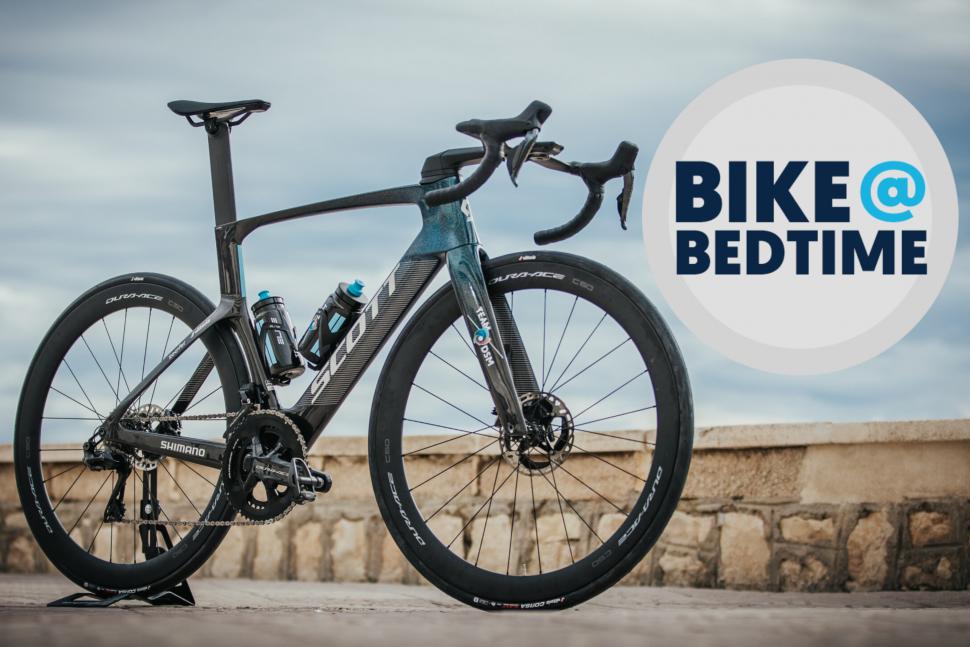
Check out the WorldTour sprint-winning Scott Foil RC aero road bike
We've already seen plenty of the Scott Foil RC at the WorldTour races - this is the bike that Charlotte Kool sprinted to stage win at the opening stage of the Women’s UAE Tour, and the men’s team is surely going to offer us more close-ups and demonstrations of the Foil's abilities at the Men's UAE Tour that is about to kick off tomorrow.
This pro bike is also the very same that Aaron reviewed recently. But now, let's have a closer look at what makes this pro aero bike so exceptional.
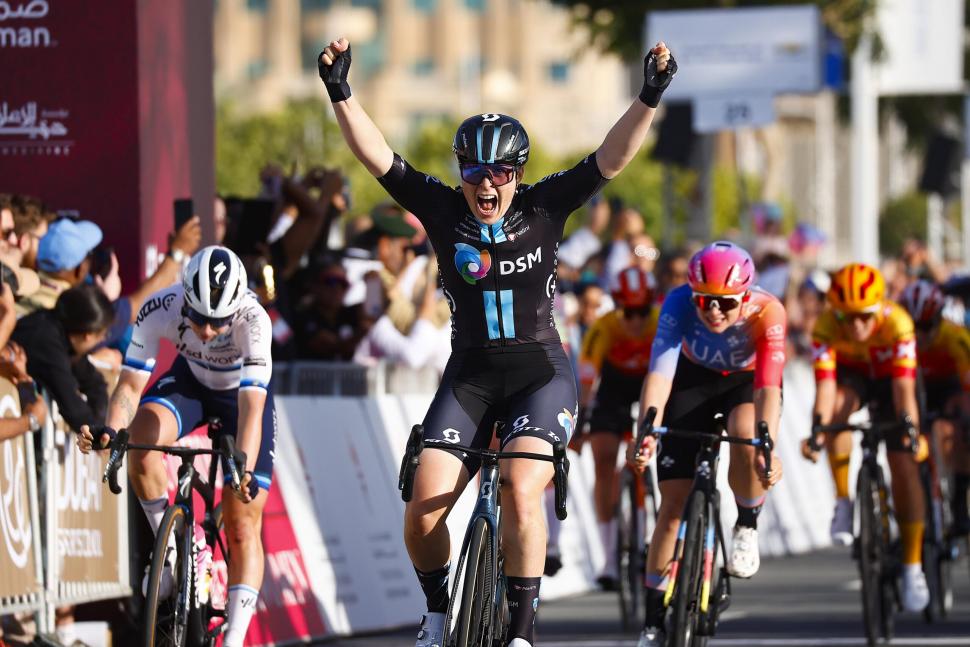
Scott has been working with Team DSM for a couple of years now and the team is the only WorldTour team riding the Swiss brand's designs, including the all-new Foil RC, which the team raced for the first time in 2022. Scott's bikes are probably partially responsible for the team's successes, which since 2021 include multiple Grand Tour stage wins and wearing the first yellow jersey at the inaugural Tour de France Femmes.
> Best aero road bikes 2023 — wind-cheating bikes with an extra turn of speed
The new Foil RC comes with a stunning, sophisticated colourway that seems to neatly match DSM's team colours, and has been designed around three aspects: "aero, lightweight and comfort". It's what Scott calls the next evolution of aero bikes, made for WorldTour sprinters, attackers and breakaway riders, and is supposedly the fastest Scott bike out there.
The speediness is made possible by the aero frame with dropped seat stays, but also the advanced components.
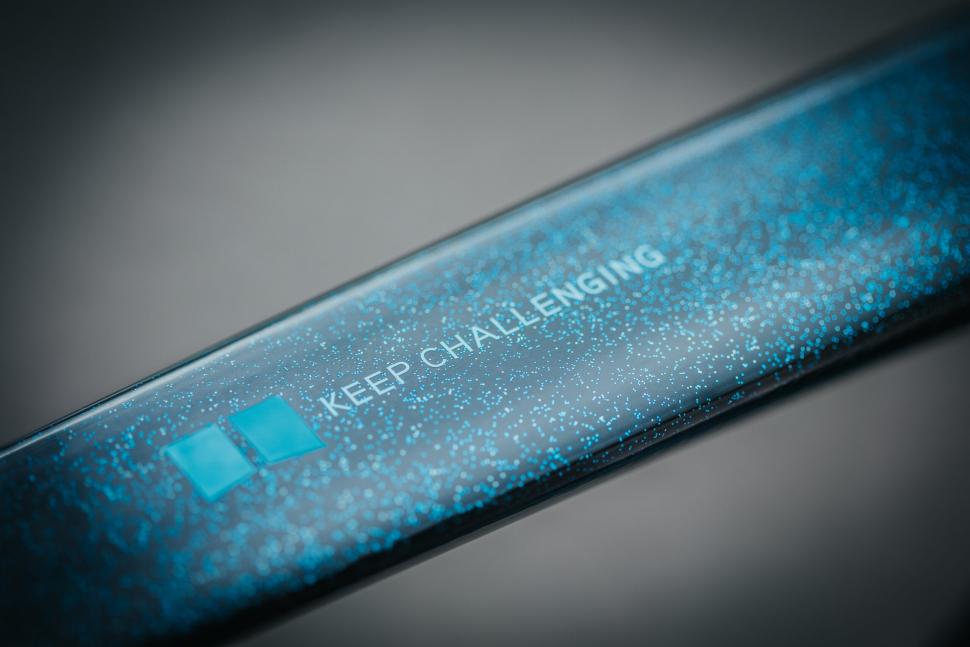
One of the most innovative features of the Foil is their patented Syncros Duncan SL Aero CFT seatpost. It should offer comfort on light gravel and cobbles alike, and simultaneously ensure that you're delivering maximum power through the pedals because you're not bouncing around on your saddle. It's made of two parts; the front is a flexible carbon fibre piece that dampens any bumps and the rear can be taken apart, so to say, and you can slot in a rear light that maintains the super aero qualities of the post.
> One bike to rule them all: why lightweight aero bikes are now THE essential race weapon
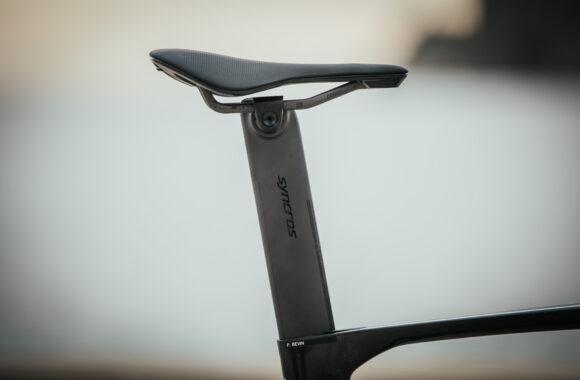
Team DSM is partners with Shimano, so it is no surprise that the Foil here is equipped with a Dura-Ace Di2 groupset and Shimano wheels, and that's what consumers can also get if they can afford to buy the Foil RC Pro model.
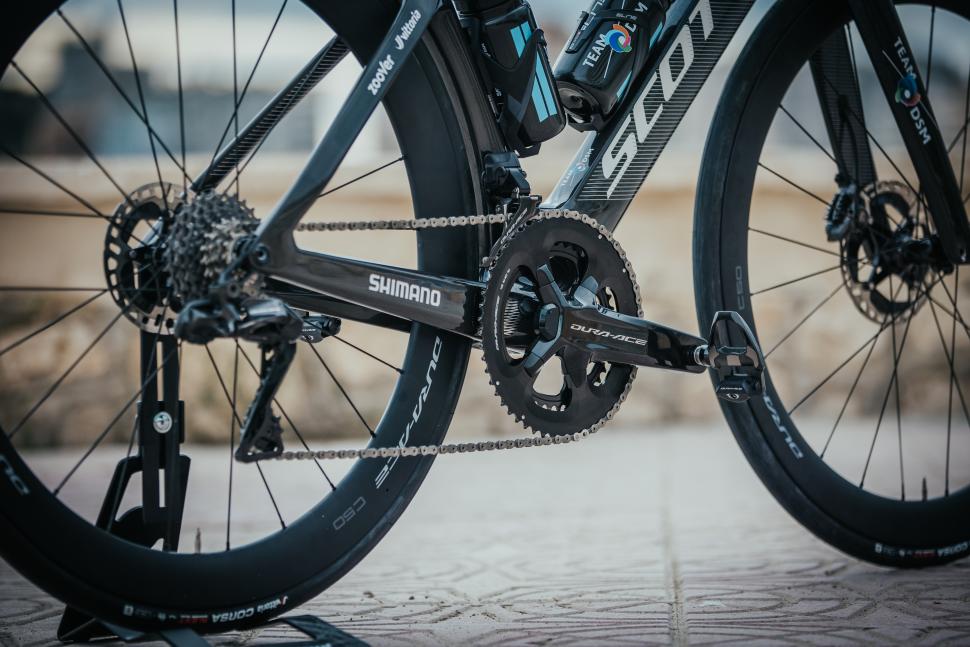
The Dura-Ace wheels are rolling on Vittoria tyres and although the pros likely change their tyre widths to suit the race conditions, the Foil RC Pro that is available for consumers comes with a 26mm tyre at the front and 28m at the back.
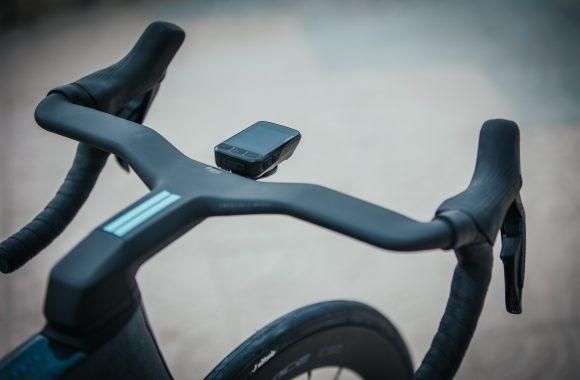
The cockpit on the Foil is a beautifully integrated (and perhaps somewhat of a mechanics nightmare) Syncros Creston iC SL Aero that weighs a mere 335g - and you can see DSM is riding with Wahoo. Still, the Aero computer mount can take any cycling computer with the right insert.
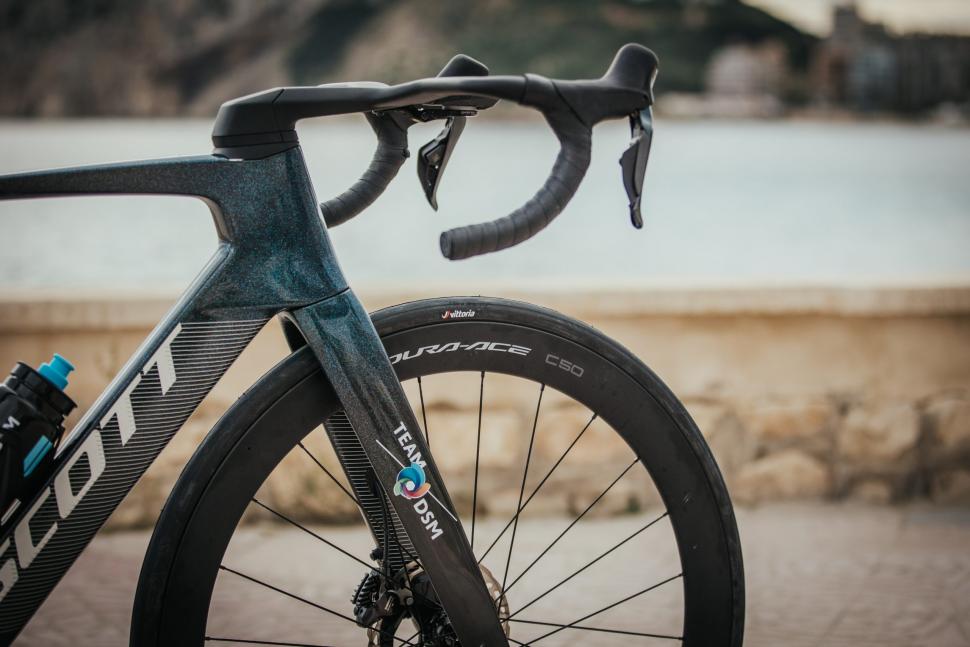
And the weight? Scott says the bike weighs 7.32kg - in what size, we don't know but that is still a very lightweight bike. Buying one of them will make your pockets lighter, too, as the Foil RC Pro model retails for £10,499.
Take a look at more cool bedtime bikes here .
Help us to fund our site
We’ve noticed you’re using an ad blocker. If you like road.cc, but you don’t like ads, please consider subscribing to the site to support us directly. As a subscriber you can read road.cc ad-free, from as little as £1.99.
If you don’t want to subscribe, please turn your ad blocker off. The revenue from adverts helps to fund our site.
Help us to bring you the best cycling content
If you’ve enjoyed this article, then please consider subscribing to road.cc from as little as £1.99. Our mission is to bring you all the news that’s relevant to you as a cyclist, independent reviews, impartial buying advice and more. Your subscription will help us to do more.
Suvi joined F-At in 2022, first writing for off-road.cc. She's since joined the tech hub, and contributes to all of the sites covering tech news, features, reviews and women's cycling content. Lover of long-distance cycling, Suvi is easily convinced to join any rides and events that cover over 100km, and ideally, plenty of cake and coffee stops.
Add new comment
Latest comments.
Thank you - that seems to make sense given the other rules. I'm not sure the paragraph I quoted is as clear as it could be then, as I'd naturally...
One more sleep.
Until they can replace it with something with a bold and exciting new design that's much less usable?
I have the Unior sprocket wear indicator tool, around £20 I think, and it takes a bit of the guesswork out of whether to change a cassette or not....
Never got my money back from Birmingham, I'd better get this lot back. No idea what to do for next summer. Closed roads seem to be a luxury that...
_I_ believe that using a bikelane should also be compulsary for drivers when a bikelane is available (forced to use a bike instead of cars, for...
Someone else actually completed a most astonishing lap earlier.. https://escapecollective.com/i-had-so-much-fun-the-story-of-lael-wilcoxs...
Looks like we left behind 'the attitude of the UK police towards cyclists' when the Republic gained its independence!
Oh look! A spesh' SL6
Good point.

- Mountain Biking
- Buyer’s Guide
- Gear Reviews
- Rides+Events
- Training Guide
- Maintenance

Scott launches the all-new Foil RC: faster, lighter, more comfortable
New frame is most aero yet.
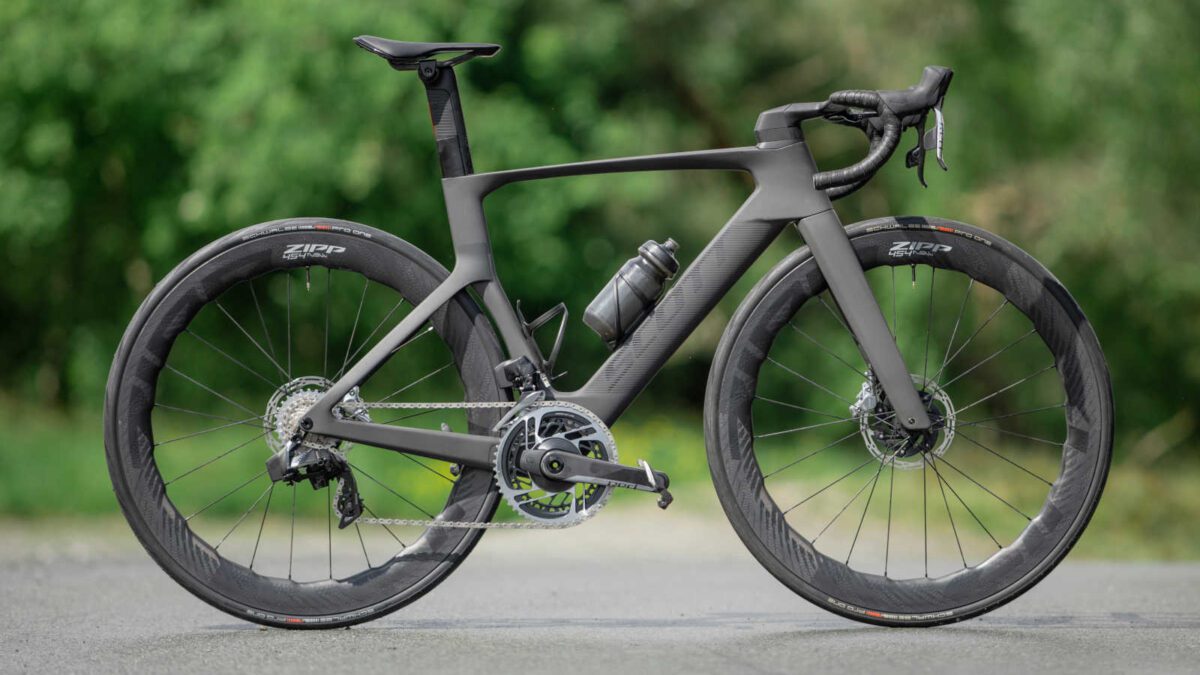
On Tuesday, Scott launched the new Foil RC aero bike. After an update to UCI regulations on bike design in 2021, Scott engineers and designers did a retool on their Foil frames. Scott says that the result is one of the fastest bikes the company has ever produced. The new bike has a 1:18 gain over 40 km compared to the previous Foil, and it’s even lighter.

Scott’s offset steerer allows for fully integrated cable routing for both mechanical and electronic shifting, breaking the air as a rider powers forward. Combined with a deeper cross section and higher crown on the fork, thinner seat tube, and chain stays are angled at 10 degrees to force air into the spinning spoke. The bike also includes hidden disc brake calipers to reduce drag.

The all-new Foil RC also has new components from Syncros that help with aerodynamic gains, reduction in weight and a new focus on the comfort factor.
The Foil comes with the new Syncros Duncan SL Aero CFT seatpost. It consists of two parts, with a front carbon fiber load bearing piece that flexes when the road gets bumpy, reducing vibration felt through the saddle. The new Syncros Creston IC SL Aero handlebar has been refined in the wind tunnel to create a slimmed down combo that slices through the wind, with improved comfort and stiffness through adaptive compliance.
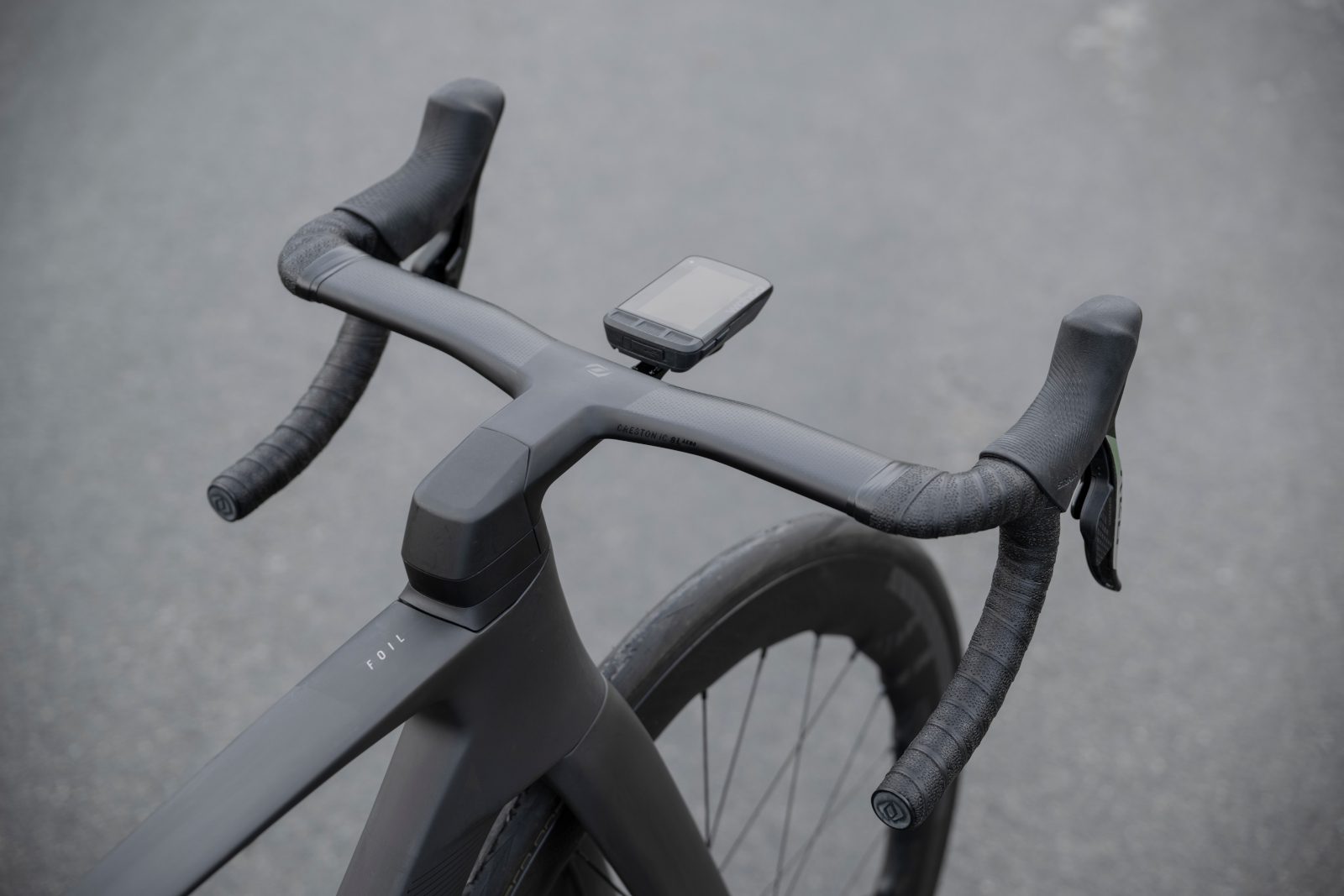
The Foil RC comes with 25mm tires up front and 28mm in the rear, with frame clearance for up to 30mm tires.
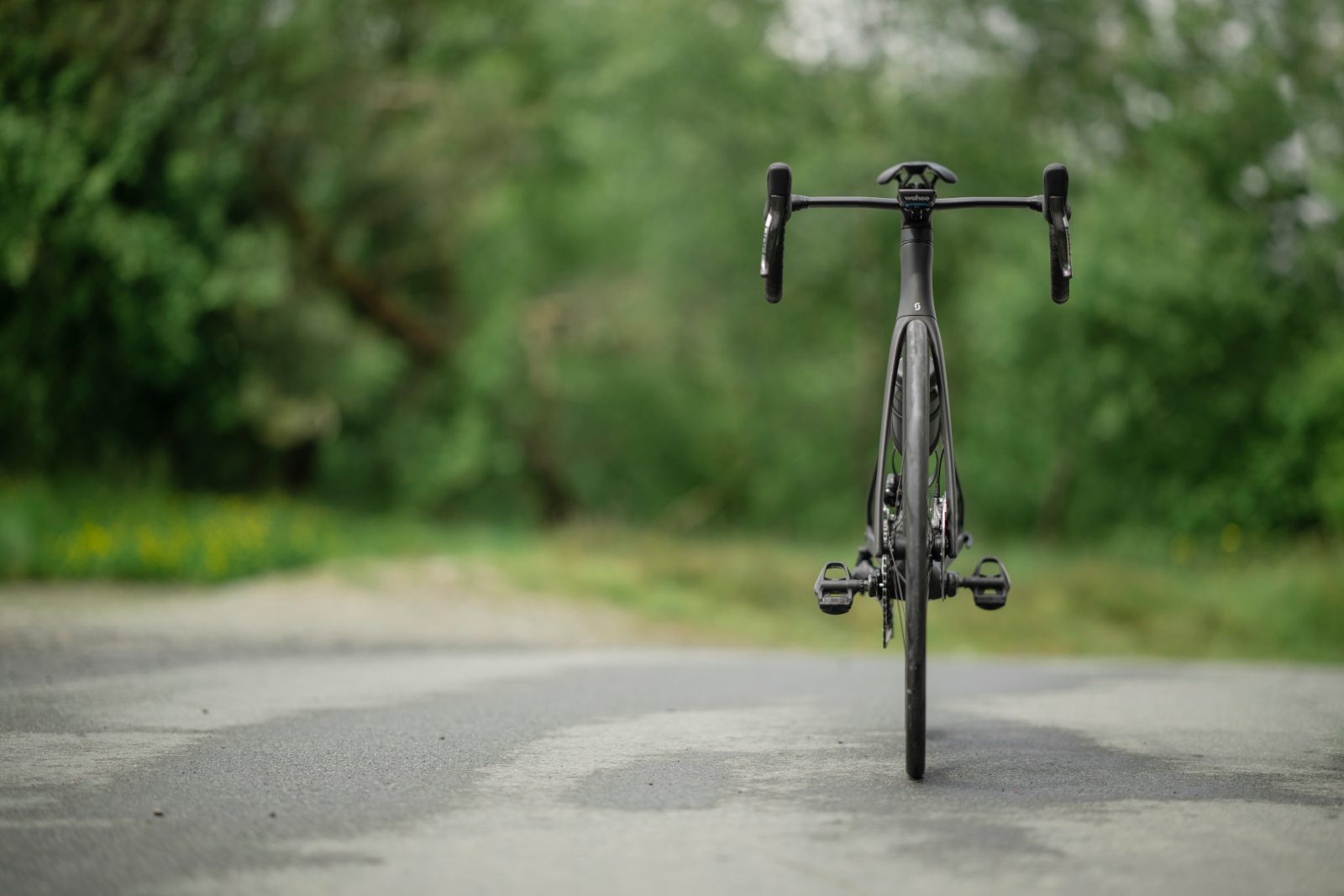
The new Foil RC comes in 5 different versions: Foil RC Ultimate, Foil RC Pro, Foil RC 10, Foil RC 20 and Foil RC 30.
You can spot the new Foil RC at the Tour de France and Tour de France Femmes. Team DSM is riding the new Scott bike in both the men’s and women’s Tours.
Foil RC Ultimate, $21,000 Foil RC Pro, $14,500 Foil RC 10, $9,400 Foil RC 20 $8,400 Foil RC 30 $6,300

- Email address: *
- Email This field is for validation purposes and should be left unchanged.
Überflieger : Scott Foil RC Ultimate im TOUR-Test
Jens Klötzer
· 15.10.2022
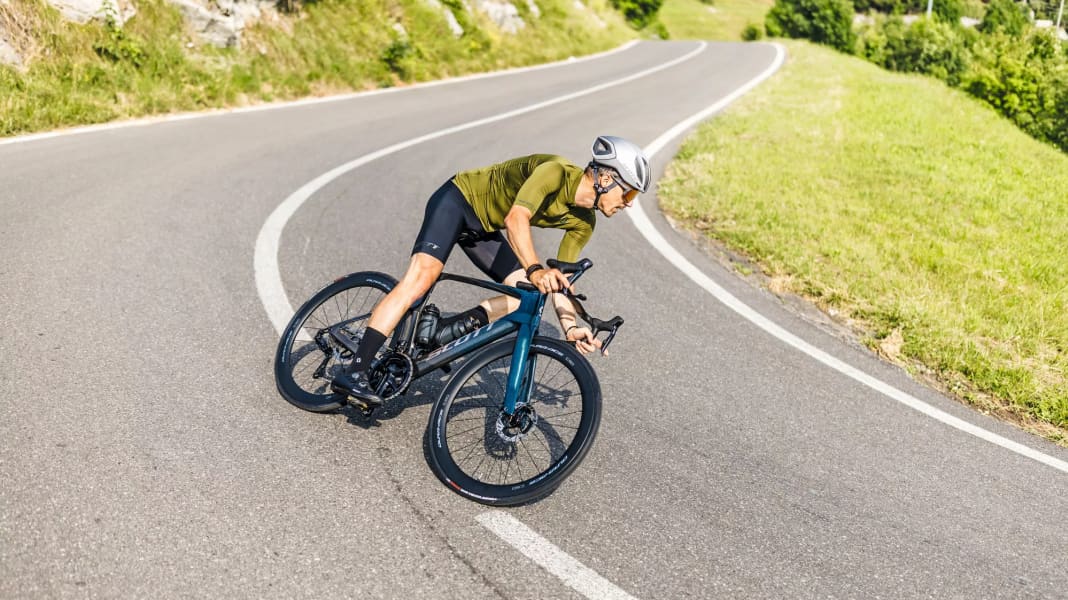
Erster Eindruck: Rakete! Scotts jüngste Interpretation des Aero-Rennrades Foil sieht aus wie ein Überschallflugzeug auf Rädern. Der extrem flächige Rahmen, parallel zur Fahrbahn verlaufende, scharfe Kanten an Steuerrohr und Tretlager, ein keilförmiger Vorbau und die fast senkrecht aus dem Rahmen ragende, tragflächenartige Sattelstütze prägen das seitliche Erscheinungsbild.
UCI-Reglement bei Scott Foil RC ausgereizt
Von vorne wirkt das Rad dagegen fast zierlich: Lenker, Gabelscheiden, Sitzstreben und Sattelstütze sind so platt gedrückt, dass man kaum glaubt, dass sie noch aus Rohren bestehen. Die Schweizer reizen die neuen Freiheiten des UCI-Reglements bei diesem Modell bis an die Grenzen aus - seit 2021 dürfen bestimmte Rohre an Rennrädern flacher und ausladender gestaltet werden als vorher. Eine so strikt aero-optimierte Rahmenform wie beim Scott Foil RC wäre vor zwei Jahren noch verboten gewesen.
Bislang verfolgte Scott bei den Vorgängermodellen die Idee, nicht alles rigoros der windschnittigen Form unterzuordnen. Mit der ersten Variante des Aero-Renners leistete der Hersteller vor zehn Jahren Pionierarbeit, seinerzeit noch mit Felgenbremsen, außen am Lenker verlaufenden Leitungen und nur angedeuteten Aero-Profilen. Der Rahmen nahm das Design heutiger Leichtbaurenner vorweg. Die nachfolgenden Generationen sind vor allem mit überdurchschnittlich guten Komfortwerten in Erinnerung - mit aerodynamischer Kompetenz verband man bisher andere Marken. Die mittlerweile vierte Generation, zur Tour de France im Juli vorgestellt , soll das nun ändern.
Meistgelesene Artikel

Gespannt waren wir daher vor allem auf die Aero-Performance, die wir schon mit einem Prototypen im Windkanal überprüfen konnten. Mit 206 Watt Tretleistung bei 45 km/h verbessert sich das Scott Foil RC zum Vorgänger um fast 10 Watt und befindet sich damit in exklusiver Gesellschaft: Prominente Konkurrenten wie Cervélo S5 , Cannondale SystemSix , Canyon Aeroad oder Pinarello Dogma F liegen auf vergleichbarem Level. Damit gehört das Foil tatsächlich zu den derzeit zehn schnellsten Rädern, die TOUR bislang gemessen hat. Ein Rekordbrecher ist es nicht, das noch radikaler designte Simplon Pride II schaffte Anfang des Jahres mit vergleichbaren Laufrädern 202 Watt – ist aber etwa 500 Gramm schwerer.
Scott Foil RC: Sattelstütze aus drei Teilen
Kompromisslos das schnellste Rad der Welt zu bauen, würde dem Anspruch der Marke Scott ohnehin nicht gerecht. Dass nicht allein die Aerodynamik oberste Priorität bei der Entwicklung hatte, merkt man allerdings erst, wenn man sich mit dem Rad näher beschäftigt.
Sinnbildlich für den erweiterten Fokus der Entwickler könnte die Sattelstütze des Rades stehen. Die besteht aus insgesamt drei Teilen - und nur der vordere, etwa einen Quadratzentimeter kleine Querschnitt trägt die Last des Fahrers. Dadurch ist die Stütze viel nachgiebiger, als es die Optik suggeriert; der Federkomfort des Rades ist extrem gut und stellt manchen Marathonrenner in den Schatten. Der Rest des Sitzrohrs wird ausgefüllt von einem Carbonformteil, das mit eingeklemmt wird und außer der aerodynamischen Form keine weitere Funktion hat. Darüber integrierten die Konstrukteure noch ein leistungsstarkes Rücklicht, dessen Sitz an unserem ersten Testrad allerdings etwas wackelig war.
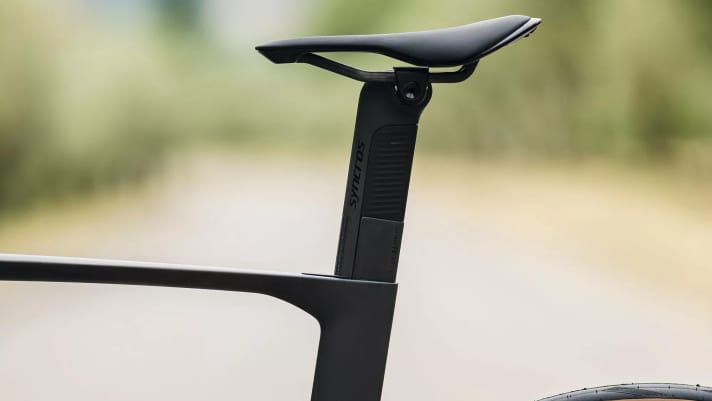
Scott Foil RC: Schnell, aber auch komfortabel
Auch die Front kann federn: Die Enden der einteiligen Lenkerkombi geben bei Stößen spürbar nach, trotzdem fühlt sich der Lenker im Sprint nicht “windelweich” an. Laufräder und Reifen verstärken den Komforteindruck zumindest beim getesteten Top-Modell zusätzlich. Der 28 Millimeter breite Hinterreifen wölbt sich über den hakenlosen Zipp-Felgen auf fast 30 Millimeter und sitzt so stabil im 23 Millimeter breiten Felgenbett, dass der Luftdruck weiter als üblich gesenkt werden kann, ohne dass sich das Rad teigig oder lahm anfühlt.
Zipp empfiehlt für einen 75-Kilo-Fahrer in dieser Konfiguration lediglich vier Bar Druck - klingt unglaublich, aber fühlt sich perfekt an. Die breiten Schlappen rollen zügig über den Asphalt, schlechte Straßen sind für das Rad überhaupt kein Problem.
Auch vom Gewicht sind wir positiv überrascht. Mit 7,2 Kilogramm ist zwar noch gut Luft zum UCI-Gewichtslimit; viel weiter ließe sich die Anzeige der Waage angesichts der elitären Ausstattung und vieler integrierter Teile auch nicht drücken. Auch im Vergleich zum Vorgänger wurde das Rad nur minimal leichter. Aber in der aerodynamisch ebenbürtigen Konkurrenz - siehe oben - zählt das Scott zu den leichteren Kandidaten. Dazu kommen die fabelhaften Komfort- und Steifigkeitswerte - auch das Scott Foil RC räumt im TOUR-Test die Bestnote von 1,4 ab - mit gegenüber dem Giant Propel leicht verschobenen Stärken und Schwächen.
2023 verspricht also schon jetzt, ein starkes Jahr für Rennrad-Fans zu werden ...
Wären da nicht die Preise. Das Scott Foil RC wird vorerst nur in zwei Versionen angeboten, für jeweils eine fünfstellige Summe: Das Foil RC Pro mit kompletter Dura-Ace-Ausstattung kostet 10999 Euro, das getestete Scott Foil RC Ultimate liegt gar bei 13999 Euro.
Fakten zum Scott Foil RC Ultimate
- Preis : 13999 Euro
- Info : www.scott-sports.com
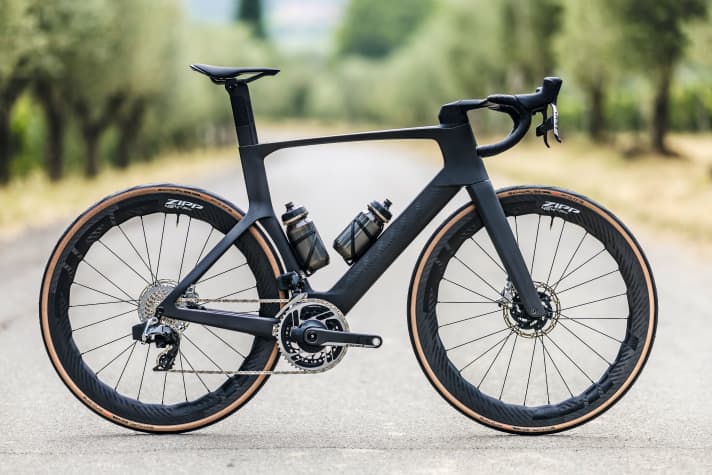
Gewicht Rahmen/Gabel/Steuerlager* 955/464/71 Gramm
Rahmengrößen** XXS, XS, S, M, L , XL, XXL
Sitz-/Ober-/Steuerrohr 545/580/170 mm
Stack/Reach/STR*** 578/394 mm/1,47
Radstand/Nachlauf 1.000/65 mm
Antrieb/Schaltung SRAM Red eTap AXS (2x12, 48/35, 10-33 Z.)
Bremsen SRAM Red (160/140 mm)
Laufräder/Reifen (Gewichte)**** Zipp 454 NSW/Schwalbe Pro One TLE 25/28 mm (1.138/1.479 Gramm)
Messwerte & Einzelnoten*****
Gewicht Komplettrad 7,2 Kilo Note : 2,3
Lenkkopfsteifigkeit 99 Nm/° Note : 1,0
Seitensteifigkeit Gabel 53 N/mm Note : 1,0
Tretlagersteifigkeit 61 N/mm Note : 1,0
Federhärte Sattelstütze 128 N/mm Note : 1,3
Aerodynamik****** 206 Watt Note : 1,3
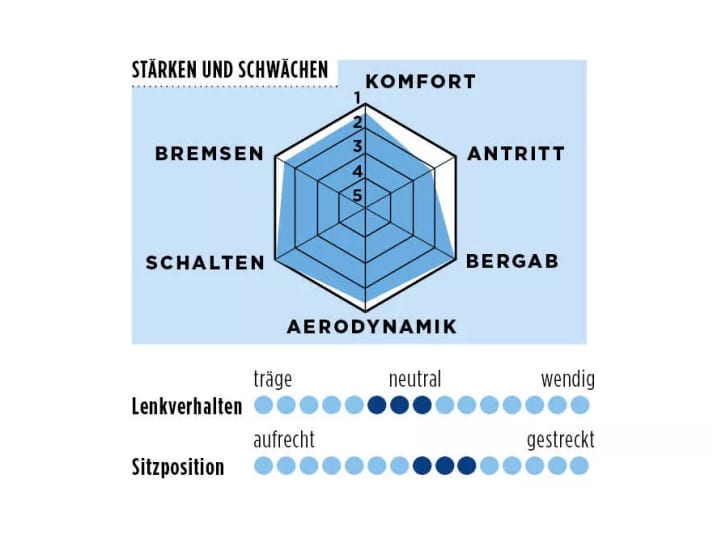
*Gewogene Gewichte. **Herstellerangabe Testgröße fett. ***Stack/Reach projiziertes senkrechtes/waagerechtes Maß von Mitte Tretlager bis Oberkante Steuerrohr; STR (Stack to Reach) 1,36 bedeutet eine sehr gestreckte, 1,60 eine aufrechte Sitzposition. ****Laufradgewichte inklusive Bereifung, Kassette, Schnellspanner/Steckachsen und ggf. Bremsscheiben. *****Einzelnoten, die unterschiedlich gewichtet in die Gesamtnote einfließen, drucken wir aus Platzgründen nur zum Teil ab. Die Noten werden bis zur Endnote mit allen Nachkommastellen gerechnet; zur besseren Übersichtlichkeit geben wir aber alle Noten mit gerundeter Nachkommastelle an. ******Aerodynamik theoretisch benötigte Tretleistung, um den Luftwiderstand bei 45 km/h zu überwinden, gemessen im Windkanal mit einem tretenden Beindummy.
Meistgelesen in der Rubrik Rennräder

- Share on Facebook
- Share on Reddit
- Aero and light
- Compliant where needed
- Spec’d for the performance consumer
- Limited bar/stem options
- No power meter
- Unbalanced compliance
Don't miss a moment of the 2024 Tour de France! Get recaps, insights, and exclusive takes with Velo's daily newsletter. >","name":"in-content-cta","type":"link"}}'>Sign up today! .
Aero bikes and fully integrated bikes are not my style, but there is something about the Scott Foil RC Pro that I love. I am not a fan of completely hidden cables and hoses because, as a person who works on my own bikes, it is a guaranteed headache to modify anything. That said, Scott has always been a brand that delivers a full system, not because it is trending but because they believe it delivers the best total experience.
The Scott Foil RC Pro is a top-level road race bike that prioritizes aero advantage. It doesn’t take any degree to understand that, but more importantly, is the Foil RC also a solid aero choice for the average rider looking for a performance road bike?
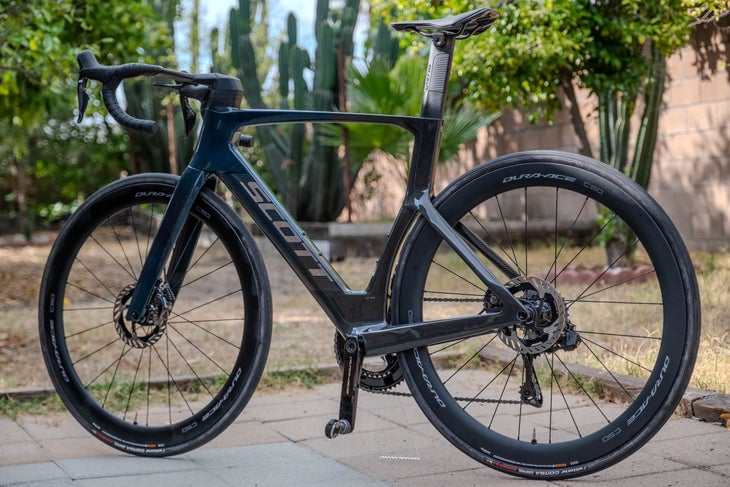
Also Read: Scott Addict RC Pro road bike review
The Bike and Build
As you might guess, the RC level bikes are expensive, and there is very little compromise regarding the build. Scott uses what they call HMX carbon for both the frame and fork. This high-modulus carbon sits at the top of their offerings. Essentially it can be thin and strong but is less durable than lower-grade modulus carbon options.
The geometry is modern, with performance road racing in mind. My size medium is equivalent to a size 54 with a 54.7cm stack and 38.9cm reach. The bike’s rear center is short with a 41cm chainstay and designed around a 25-28mm tire. Because of the aero seat tube shaping, clearance for large tires is restricted, but I did fit a 32mm tire.
The bike’s overall length is on par with most bikes in the race category, with a 98.7cm wheelbase. What sets it apart is upfront. To accommodate the internal routing and seamless design, there is a 1-inch steerer. This leaves more room for the hoses inside the headset allowing the headtube to remain narrower than many other systems. Like many other internal routing headset systems, Scott requires a specific headset spacer that is paint-matching, and they include that in their total headset length numbers on the geometry chart, which I appreciate.
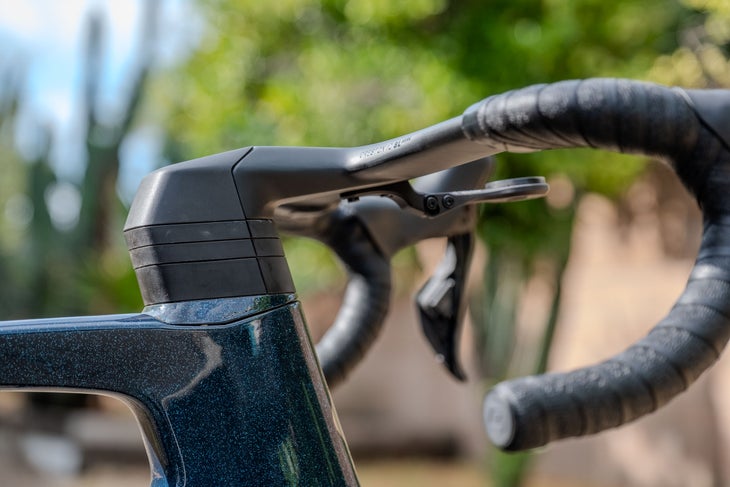
Since the RC Pro is a top-tier bike, it is spec’d like one with Shimano Dura-Ace. The semi-wireless 12-speed Di2 drivetrain is paired with a set of their C50 tubeless wheels wrapped with Vittoria Corsa Control Graphene 2 tires in size 25mm. The gearing is more consumer-friendly than UCI Pro, with a 52/36t crankset matched with the 11-30t cassette. Overall this is a top-level build, but for a bike of this caliber, it falls victim to the same thing all of the Shimano builds seem to be missing, a power meter. At this level and price, it shouldn’t be an add-on.
The rest of the build is from Scott’s house brand Syncros . The proprietary aero seatpost is 55mm deep but has a unique section of only 15mm deep. This slim section has a plastic cover, and Scott sells a light that integrates into the space.
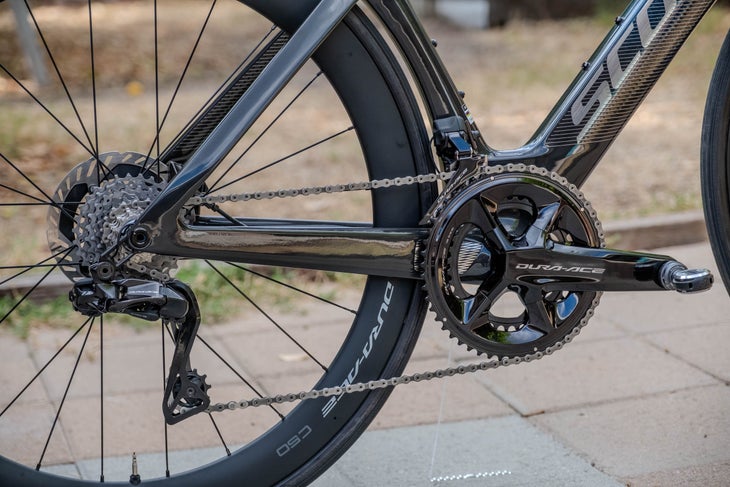
Since the Scott Foil RC Pro has a 1-inch steerer, the Syncros Creston iC SL Aero one-piece bar stem combo is one of the few options. On my size M (54), it is 40cm wide with a bar reach of 75mm and a stem length of 110mm. It was a bit narrow for me, but the total reach was pretty good.
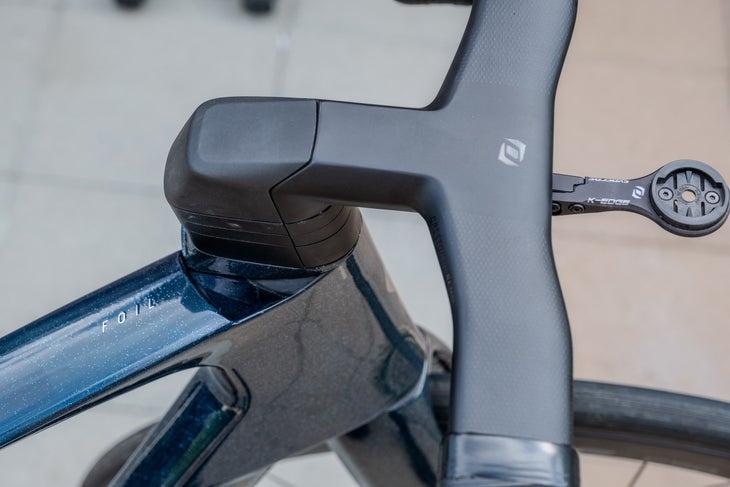
It’s pretty clear that the Scott Foil RC Pro is a top-level performance road bike that has been designed for a specific purpose, going fast. What is also true is that Scott seems to have done a very good job balancing the build and overall design also to accommodate the performance consumer. What do I mean? The bike is stable and confident, inspiring even at high speeds but gives you enough feedback that you feel the speed.
Being an aero bike normally means added weight. However, this one hit the scale at 16.37 pounds. For me, that puts it in a category that is beyond just aero. Even climbers would be happy with that and get the aero advantages.
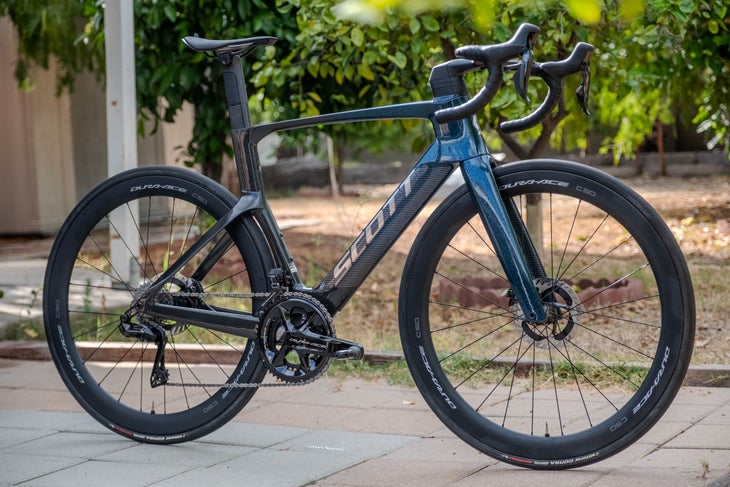
Climbing on the Foil RC Pro was much better than I expected. The unique thin section of the seatpost offered good compliance when in the saddle. It’s not an endurance bike level of compliance, but it’s not nearly as jarring and stiff as most deep-section aero tube bikes. Out of the saddle, the bike is a rocket. Whether I was pushing a big gear or spinning the legs, it felt like it was all getting transferred.
What goes up must come down, and that is where I fell in love with the Scott Foil RC Pro. The one-piece bars and overall lateral stiffness deliver a responsive bike that kept me wanting to push harder and go faster around every bend on the descents. This was a bit surprising to me since the bike has a smaller 1-inch steerer. I have noticed that the thickness of the carbon in the steerer is obvious and is making up for the smaller diameter.
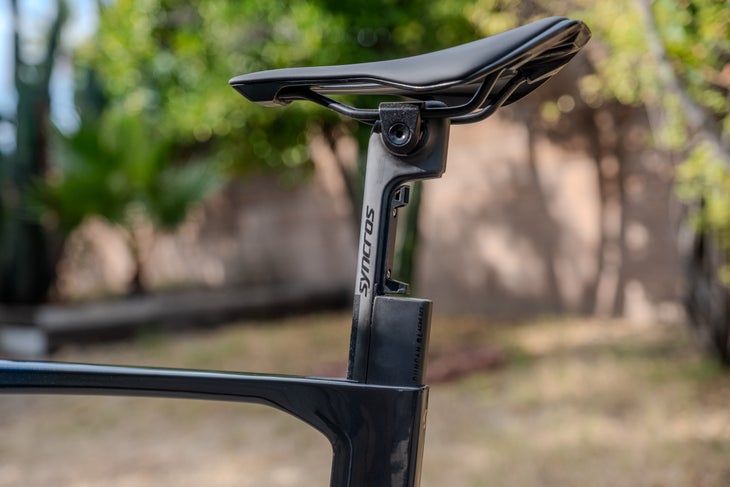
In general, the bike is very performance-oriented, and that is something I like. For me, though, the bike feels a bit unbalanced regarding compliance. The front feels the way I would expect an aero bike to feel. It’s a bit harsh on big bumps but manages overall road imperfections well. The rear, on the other hand, is much more compliant than I expected when in the saddle. Out of the saddle, it is a bit more balanced, but the front feels like it might be trying to make up for that steerer a bit too much.
With that said, I think running a 28mm tire would help a lot, and if I’m being completely honest, it has been a while since I have ridden a 25mm tire and the higher pressures. The C50 wheels have a 21mm internal width but the thin sidewalls of the Vittoria tires and smaller size had me changing tire pressure almost every ride trying to get the support and performance correct.
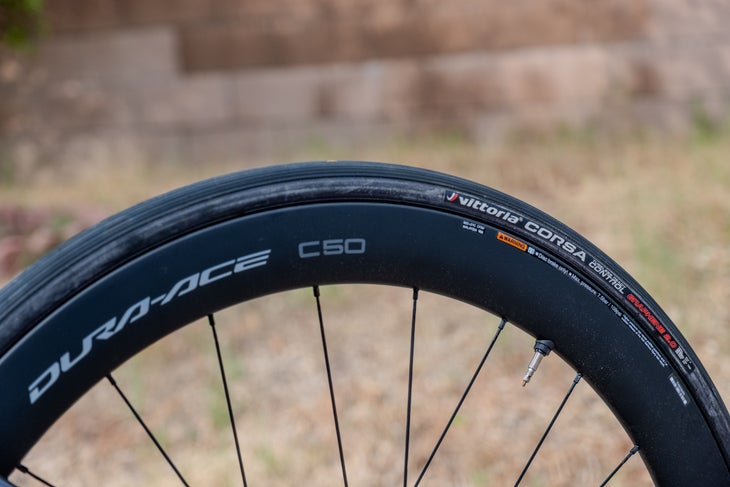
Maybe I’m a bit old school with my straight and level hoods, but the 40cm bars were also a bit narrow for my liking. It’s not so narrow that I would spend an ungodly amount of money to swap them out. Between the $600 for a new cockpit and probably $200-$400 in labor and small parts, I would accept that whatever comes on it is what I will adapt to. It’s not ideal, but it seems to be the modern way.
My last and biggest complaint is not entirely a Scott issue. It’s more of a Shimano issue. Shimano doesn’t offer a power meter, while the SRAM equivalent has one built-in. That means a performance consumer would need to get something like the new 4iiii or Stages installed. I personally have chosen the Wahoo Speedplay Powerlink Zero power pedals. Either way, at this level and price, you shouldn’t need to shop for a power meter at all. It should be included.
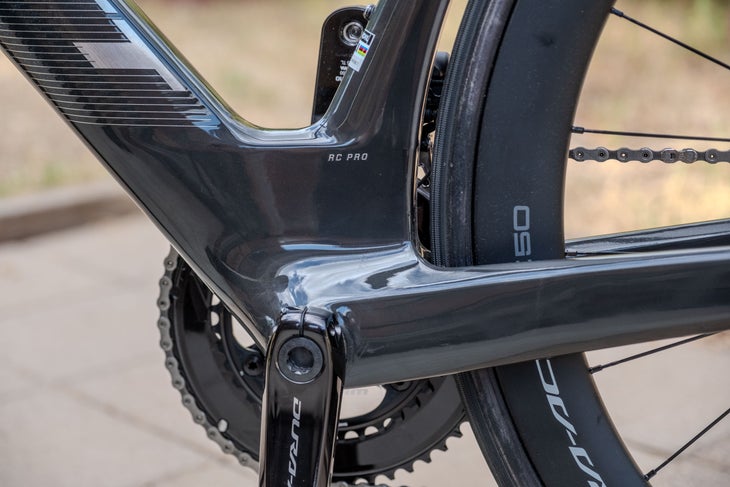
Overall the Scott Foil RC Pro is one of the few aero road bikes I could see myself owning. It balances aero, compliance, and weight fairly well while being fun to ride. Not that it matters, but it also seems to get a lot of attention on my local group rides, with everyone asking lots of questions.
Bumping the tire size to 28mm would be ideal for most and help balance the front-end stiffness compensation. I will put it out there, if you are the type of person who wants to customize your bike or have a very specific fit and are considering this bike, set some cash aside because there are not a lot of cockpit options, and they are all expensive.
Scott is one of those brands that has taken integration and proprietary components to the max early on, way before it was cool and hip. They started doing it to deliver a more controlled and reliable system that fit the design requirements they envisioned. While a lot of brands are now offering similar designs, for me, the others don’t balance the advantages and disadvantages enough when it comes to performance the way Scott has with the Foil RC Pro.
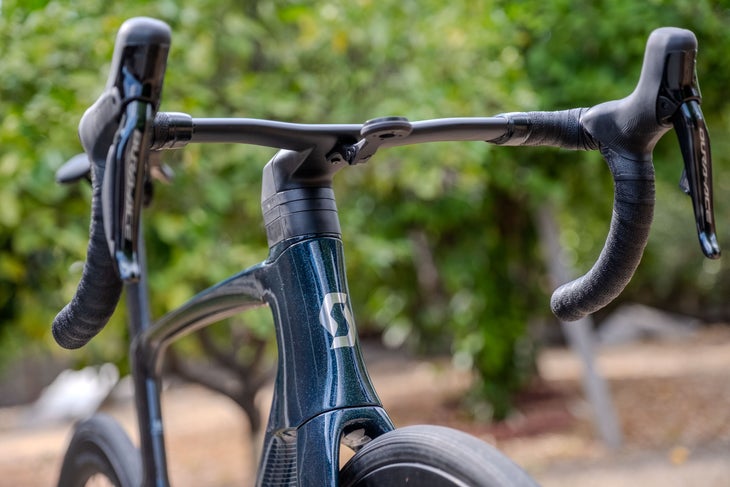
Popular on Velo
Up close with the new Scott Foil RC: John Degenkolb's Tour de France bike
On the day he returns to the scene of perhaps his greatest triumph, we check out the Team DSM rider's machine
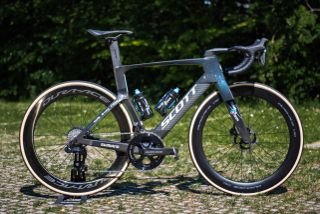
A week on from its official launch, we're taking a close look at the new Scott Foil RC. In particular, we're focussing on the bike of Team DSM's John Degenkolb, at the start of a day which has no doubt been highlighted on his calendar for some time. The 2015 winner of Paris-Roubaix should feel at home during the second half of today's Tour de France stage from Lille Metropole to Arenberg Porte du Hainaut, since it includes 11 sectors of cobbles, the last of which ends just 5km before the stage finish.
The first non-French rider to have a cobbled sector named in his honour, the 3.7km long d'Hornaing à Wandignies-Hamage sector has been known as Secteur John Degenkolb since 2020 and lies just a cobblestone's throw from the Tour's route. He was also first across the line last time the Tour de France hit the cobbles of Northern France, beating Greg Van Avermaet and Yves Lampaert in Roubaix in 2018.
If any more inspiration were needed, Degenkolb has Scott's latest road aero machine at his disposal, which claims to be lighter, stiffer and faster than the previous model. Extensive collaboration with Drag2Zero's Simon Smart has reportedly resulted in 10 per cent greater aerodynamic efficiency, or a 16-watt saving at 40km/h, translating to 1min 18sec saving in 40km.
The geometry now mimics that of the crisp-handling Addict RC, and a painted 56cm frame with all hardware attached is said to weigh 915g, 9 per cent lighter than before. The fine details of the new Scott Foil RC hint at its improved aerodynamics and rider comfort, two qualities that any road pro will welcome, especially during the Hell of the North.
Keep on scrolling to see the details.
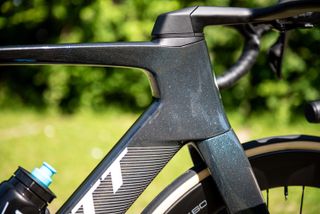
Get The Leadout Newsletter
The latest race content, interviews, features, reviews and expert buying guides, direct to your inbox!

Thank you for reading 5 articles in the past 30 days*
Join now for unlimited access
Enjoy your first month for just £1 / $1 / €1
*Read any 5 articles for free in each 30-day period, this automatically resets
After your trial you will be billed £4.99 $7.99 €5.99 per month, cancel anytime. Or sign up for one year for just £49 $79 €59
Try your first month for just £1 / $1 / €1
- Peter Stuart Editor
Types of road bike: Your drop-bar options unpacked
Campagnolo launches Super Record S Wireless groupset with new gearing options and a (slightly) more affordable price
Primož Roglič's Vuelta a España victory was inevitable - Philippa York's analysis
Most Popular
Scott Foil 10 review
We put Scott's aero bike through its paces
- Sign up to our newsletter Newsletter
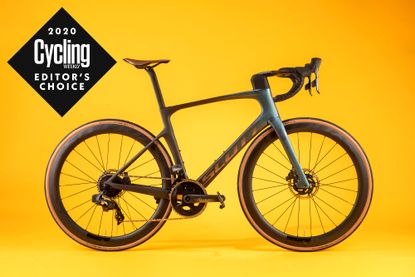
The Scott Foil is a dream race bike that will make you excited to get out on a ride. It’s not the most comfortable, but then it is an aero race bike and that's par for the course to an extend. It climbs with grace and handles as well as any all-rounder. The improved integration via the new Syncros bar is a winner, too.
Truly rapid
Aesthetically beautiful
Not particuarly comfortable
You can trust Cycling Weekly. Our team of experts put in hard miles testing cycling tech and will always share honest, unbiased advice to help you choose. Find out more about how we test.
The Scott Foil 10 was selected for an Editor's Choice award in 2020. This year's list contains 78 items which scored a 9 or 10/10 with our tech team - this gear is the best of the best, and has received the Cycling Weekly stamp of approval.
Scott's Foil has gained a reputation for being the 'roadman(or woman)'s aero race bike - it's optimized to be fast, but in the process hasn't lost some of the characteristics often bestowed on lightweight all-rounders.
The 2021 iteration has a new party trick of complete cable integration, made possible by the Syncros Creston iC SL Carbon combo cockpit which was first released via the Addict . In fact, the two bikes look very similar and there's definitely the beginnings of a convergence of the brand's lightweight and aero bikes.
Every time Cycling Weekly has tested a new model, we've been blown away by this bike - and this frame is near identical to the 2020 version, all that's changed is the front end. So it's no surprise that we were impressed.
Scott Foil 10: Frame
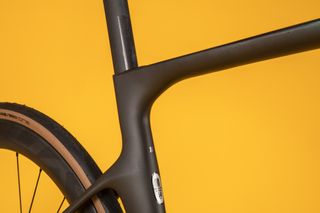
Despite its similarity to the GC bike, the Addict, the Scott Foil has all the hallmarks of an aero design: Scott's own patented aero shapes at the down tube, head tube, seat tube, seat post and seat stays - which of course are dropped. It gains a little weight in the process, our size medium came in at 7.8kg.
The bottom bracket area is chunky and ready for those all-out sprints, and of course there's the new integration via the Syncros Creston iC SL Carbon combo front end.
This bar and stem combo sweeps back into an aero design, and also promises additional comfort - whilst we don't have a windtunnel to test the former claim, the latter was something we certainly noticed coming through in the ride when comparing to the outgoing version.

The cable routing is entirely internal - so you won't be noticing any of those nasty paint-wear marks over time and of course there's the minutest of aero savings promised - plus the overall aesthetics.
The system is one we've discussed at length with local bike shop mechanics, it sees the cables run through the bar, into the headset and into the frame and of the systems out there it's not a total pig to work with (though to be clear - internal cables will always be more time consuming to replace than external, at least this decade).
Scott also includes its aero cover over the disc brake calipers - this attaches via a magnet, and we noticed on very long mountainous descents, tiny shavings of rotor actually became attached to the cover - though perhaps this was a symptom of the breaks wearing in!
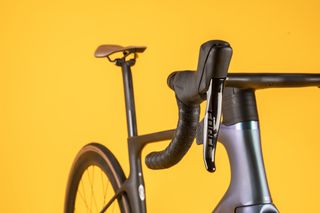
Split spacers mean that front end adjustments are fairly easy, though the aero top cap means that you'll have to use a round version until you chop the steerer if you are dropping the bars.
There's space for tyres up to 30mm, which is a nice to have, though we'd currently be sticking with the specced 28mms on a bike designed for racing.
The Foil is a little higher than some competitors - a size Medium (550mm headtube) carries a stack of 547.5mm and a reach of 388.9mm. However, there's plenty of adjustment available via the spacers, so I can't see a rider seeking a long and low position having any issues there. Comparatively, a Cannondale SystemSix comes with a 540mm, a difference that could be achieved with less than a 10mm spacer. The 72.5º had angle and 987mm wheelbase make for snappy handling, more so than competitors in this aero arena.
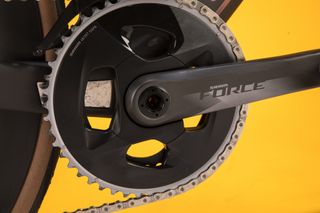
This Scott Foil comes sporting SRAM Force eTap AXS, which in our experience has always been an excellent system - featuring nearly all the rewards of SRAM Red eTap AXS but at a more friendly price tag.
Most of the finishing kit comes from Scott's Syncros brand, including the Syncros Capital 1.0 50 disc wheels. These certainly are not a case of providing stock wheels under the expectation you will upgrade, they're fast and responsive and didn't seem to slow me down. The very same wheels feature on the higher end Scott Foil Pro bike, retailing at £8,099 - which gives you an idea where these belong on the scale.
The tyres are the excellent Schwalbe ONE Race-Guard Tires, in 28mm - and these complement the bike no end, offering comfort to the chassis as well as excellent cornering grip.
Scott has also adorned this model with the Syncros Duncan 1.0 Aero seatpost, which is d-shaped and aims to reduce road buzz, something we'd say it does very effectively considering the aero nature of the frame and balanced ride quality on offer.
The Foil is an utter dream race bike to ride. It’s fast, stiff, climbs with grace and just looks so stylish, with its metallic finish purple blue paint-job, you catch a lot of eyes on the road. When you pass it in the hall or happen to enter the garage you can't help but spare longingly at it. It makes you want to ride.
The most notable talking point on the Scott Foil is the way it manages to so elegantly balance the speed requirements of an aero bike with the cornering and climbing capabilities that come sometimes be lost in the pursuit of all out speed.
The frame and wheels together definitely upped my pace - I found myself easily setting time PBs on just about every Strava segment whenever I turned on the gas, finding myself comfortably sitting at 32Kph on a long straight stretch of road without feeling the pinch. Even on the climbs this thing is fast.
There is the obvious comfort trade-off when riding a bike this fast is the ride quality – it’s never going to be a comfortable all-day bike for those who want to relax into their ride. However, enough has been done via the extra compliance at the handlebar and seatpost, plus the addition of 28mm tyres, that it's not a bumpy ride either.
Of course, the £5399 price tag is a heavy investment - but it's in line with the competition. A Trek Madone SL 7 comes with Shimano Ultegra Di2, costing £5450 whilst the Giant Propel Advanced Pro 0 disc also with Shimano Dura ace will set you back £5299 - each coming with finishing kit, including wheels, from the brand's in-house roster.
Thank you for reading 20 articles this month* Join now for unlimited access
Enjoy your first month for just £1 / $1 / €1
*Read 5 free articles per month without a subscription
Join now for unlimited access
Try first month for just £1 / $1 / €1
Get The Leadout Newsletter
The latest race content, interviews, features, reviews and expert buying guides, direct to your inbox!
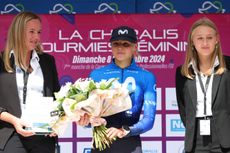
Get ready for the next generation of British success, but can it last forever with a shrinking calendar?
By Adam Becket Published 10 September 24

The American Paralympian has competed in 7 Paralympic Games in 3 very different sports and has won 19 medals.
By Kristin Jenny Published 10 September 24

Thirty-year-old privateer says he's 'not desperate' for a pro contract
By Tom Davidson Published 10 September 24
Useful links
- Tour de France
- Giro d'Italia
- Vuelta a España
buyers-guides
- Best road bikes
- Best gravel bikes
- Best smart turbo trainers
- Best cycling computers
- Editor's Choice
- Bike Reviews
- Component Reviews
- Clothing Reviews
- Contact Future's experts
- Terms and conditions
- Privacy policy
- Cookies policy
- Advertise with us
Cycling Weekly is part of Future plc, an international media group and leading digital publisher. Visit our corporate site . © Future Publishing Limited Quay House, The Ambury, Bath BA1 1UA. All rights reserved. England and Wales company registration number 2008885.
- Feb 21, 2021
- 20 min read
The Dyatlov Pass Incident
What is the Dyatlov Pass incident? Well, as we’ll find out, it was when nine Russian hikers died in the northern Ural Mountains between February 1st & 2nd in 1959, under supposed uncertain circumstances. The experienced trekking group, who were all from the Ural Polytechnical Institute , had established a camp on the slopes of Kholat Syakhl , in an area now named in honour of the group's leader, Igor Dyatlov. During the night, something caused them to cut their way out of their tent and attempt to flee the campsite while not being dressed for the heavy ass snowfall and subzero temperatures. Subzero was one of my favorite Mortal Kombat characters… god I loved that game.
After the group's bodies were grusomly discovered, an investigation by Soviet authorities determined that six of them had died from hypothermia while the other three had been killed by physical trauma . One victim actually had major skull damage, two had severe chest trauma, and another had a small crack in the skull . Was all of this caused by an avalanche or from something nefarious? Four of the bodies were found lying in running water in a creek, and three of these had soft tissue damage of the head and face – two of the bodies were missing their eyes, one was missing its tongue, and one was missing its eyebrows. It’s eyebrows! The Soviet investigation concluded that a "compelling natural force" had caused the untimely deaths. Numerous theories have been brought forward to account for the unexplained deaths, including animal attacks, hypothermia, avalanche , katabatic winds , infrasound -induced panic, military involvement, or some combination of these. We’ll discuss all these in further detail later on.
Recently, Russia has opened a new investigation into the Dyatlov incident in 2019, and its conclusions were presented in July 2020: Simply put, they believe that an avalanche had led to the deaths of the hikers. Survivors of the avalanche had been forced to suddenly leave their camp in low visibility conditions with inadequate clothing, and had died of hypothermia. Andrey Kuryakov, deputy head of the regional prosecutor's office, said: "It was a heroic struggle. There was no panic. But they had no chance to save themselves under the circumstances." A study published in 2021 suggested that a type of avalanche known as a slab avalanche could explain some of the injuries. However, we’ll run through everything and you can come to your own conclusion.
Ok, let’s dive into the details of the event.
In 1959, the group was formed for a skiing expedition across the northern Urals in Sverdlovsk Oblast, Soviet Union. According to Prosecutor Tempalov, documents that were found in the tent of the expedition suggest that the expedition was named for the 21st Congress of the Communist Party of the Soviet Union, and was possibly dispatched by the local Komsomol organisation.Which was a political youth organization in the Soviet Union , which was sometimes described as the youth division of the Communist Party of the Soviet Union . Igor Dyatlov, a 23-year-old radio engineering student at the Ural Polytechnical Institute; now Ural Federal University, was the leader who assembled a group of nine others for the trip, most of whom were fellow students and peers at the university.Ok, so they were mostly students. Each member of the group, which consisted of eight men and two women, was an experienced Grade II-hiker with ski tour experience, and would be receiving Grade III certification upon their return. So, this trekk was like a test. I hated tests. Especially ones that could KILL YOU! At the time, this was the highest certification available in the Soviet Union, and required candidates to traverse 190 mi. The route was designed by Igor Dyatlov's group in order to reach the far northern regions of Sverdlovsk Oblast and the upper-streams of the Lozva river. The route was approved by the Sverdlovsk city route commission, which was a division of the Sverdlovsk Committee of Physical Culture and Sport. They approved of and confirmed the group of 10 people on January 8th, 1959. The goal of the expedition was to reach Otorten, a mountain(6.2 mi north of the site where the incident took place. This path, taken in February, was estimated as a Category III, the most difficult time to traverse.
On January 23rd, 1959 the Dyatlov group was issued their route book which listed their course as following the No.5 trail. At that time, the Sverdlovsk City Committee of Physical Culture and Sport listed approval for 11 people. The 11th person was listed as Semyon Zolotaryov who was previously certified to go with another expedition of similar difficulty (that was the Sogrin expedition group). The Dyatlov group left the Sverdlovsk city (today called Yekaterinburg) on the same day they received the route book.
The members of the group were Igor Alekseyevich Dyatlov, Yuri Nikolayevich Doroshenko, Lyudmila Alexandrovna Dubinina, Georgiy (Yuri) Alexeyevich Krivonischenko, Alexander Sergeyevich Kolevatov, Zinaida Alekseevna Kolmogorova, Rustem Vladimirovich Slobodin, Nikolai Vladimirovich Thibeaux-Brignolles, Semyon (Alexander) Alekseevich Zolotaryov, and Yuri Yefimovich Yudin
The group arrived by train at Ivdel , a town at the centre of the northern province of Sverdlovsk Oblast in the early morning hours of January 25, 1959. They took a truck to Vizhai, a little village that is the last inhabited settlement to the north. As of 2010, only 207 really, really fucking cold people lived there. While spending the night in Vizhai, and probably freezing their baguettes off, the skiers purchased and ate loaves of bread to keep their energy levels up for the following day's hike.
On January 27, they began their trek toward Gora Otorten. On January 28, one member, Yuri Yudin, who suffered from several health ailments (including rheumatism and a congenital heart defect ) turned back due to knee and joint pain that made him unable to continue the hike. The remaining nine hikers continued the trek. Ok, my first question with this is, why in the fuck was that guy there, to begin with??
Diaries and cameras found around their last campsite made it possible to track the group's route up to the day before the incident. On January 31st, the group arrived at the edge of a highland area and began to prepare for climbing. In a wooded valley, they rounded up surplus food and equipment that they would use for the trip back. The next day, the hikers started to move through the pass. It seems they planned to get over the pass and make camp for the next night on the opposite side, but because of worsening weather conditions—like snowstorms, decreasing visibility... large piles of yeti shit—they lost their direction and headed west, toward the top of Kholat Syakhl . When they realised their mistake, the group decided to set up camp there on the slope of the mountain, rather than move almost a mile downhill to a forested area that would have offered some shelter from the weather. Yudin, the debilitated goofball that shouldn’t have even been there speculated, "Dyatlov probably did not want to lose the altitude they had gained, or he decided to practice camping on the mountain slope."
Before leaving, Captain Dyatlov had agreed he would send a telegram to their sports club as soon as the group returned to teeny, tiny Vizhai. It was expected that this would happen no later than February 12th, but Dyatlov had told Yudin, before he departed from the group, that he expected it to actually be longer. When the 12th passed and no messages had been received, there was no immediate reaction because, ya know… fuck it. Just kidding, these types of delays were actually common with such expeditions. On February 20th, the travellers' worried relatives demanded a rescue operation and the head of the institute sent the first rescue groups, consisting of volunteer students and teachers. Later, the army and militsiya forces (aka the Soviet police) became involved, with planes and helicopters ordered to join in on the search party.
On February 26th, the searchers found the group's abandoned and super fucked up tent on Kholat Syakhl . The campsite undoubtedly baffled the search party. Mikhail Sharavin, the student who found the tent, said “HOLY SHIT! THIS PLACE IS FUCKED UP!”... No, that’s not true. He actually said, "the tent was half torn down and covered with snow. It was empty, and all the group's belongings and shoes had been left behind." Investigators said the tent had been cut open from inside. Which seems like a serious and quick escape route was needed. Nine sets of footprints, left by people wearing only socks or a single shoe or even barefoot, could actually be followed, leading down to the edge of a nearby wood, on the opposite side of the pass, about a mile to the north-east. After approximately 1,600 ft, these tracks were covered with snow. At the forest's edge, under a large Siberian pine , the searchers found the visible remains of a small fire. There were the first two bodies, those of Krivonischenko and Doroshenko, shoeless and dressed only in their tighty whiteys. The branches on the tree were broken up to five meters high, suggesting that one of the skiers had climbed up to look for something, maybe the camp. Between the pine and the camp, the searchers found three more corpses: Dyatlov, Kolmogorova, and Slobodin, who died in poses suggesting that they were attempting to return to the tent. They were found at distances of 980, 1,570, and 2,070 ft from the tree.
Finding the remaining four travellers took more than two frigging months. They were finally found on May 4th under 13 ft of snow in a ravine 246 ft further into the woods from the pine tree. Three of the four were better dressed than the others, and there were signs that some clothing of those who had died first had been taken off of their corpses for use by the others. Dubinina was wearing Krivonishenko's burned, torn trousers, and her left foot and shin were wrapped in a torn jacket.
Let’s get into the investigation. A legal inquest started immediately after the first five bodies were found. A medical examination found no injuries that might have led to their deaths, and it was concluded that they had all died of hypothermia .Which would make sense because it was colder than a polar bear’s butthole. Slobodin had a small crack in his skull, but it was not thought to be a fatal wound.
An examination of the four bodies found in May shifted the overall narrative of what they initially believed transpired. Three of the hikers had fatal injuries: Thibeaux-Brignolles had major skull damage, and Dubinina and Zolotaryov had major chest fractures. According to Boris Vozrozhdenny, the force required to cause such damage would have been extremely high, comparable to that of a car crash.Also, the bodies had no external wounds associated with the bone fractures, as if they had been subjected to a high level of pressure.
All four bodies found at the bottom of the creek in a running stream of water had soft tissue damage to their head and face. For example, Dubinina was missing her tongue, eyes, part of the lips, as well as facial tissue and a fragment of her skullbone, while Zolotaryov was missing his friggin eyeballs, and Aleksander Kolevatov his eyebrows. V. A. Vozrozhdenny, the forensic expert performing the post-mortem examination , judged that these injuries happened after they had died, due to the location of the bodies in a stream.
At first, there was speculation that the indigenous Mansi people , who were just simple reindeer herders local to the area, had attacked and murdered the group for making fun of Rudolph. Several Mansi were interrogated, but the investigation indicated that the nature of the deaths did not support this hypothesis: only the hikers' footprints were visible, and they showed no sign of hand-to-hand struggle. Oh, I was kidding about the Rudolph thing. They thought they attacked the hikers for being on their land.
Although the temperature was very low, around −13 to −22 °F with a storm blowing, the dead were only partially dressed, as I mentioned.
Journalists reporting on the available parts of the inquest files claim that it states:
Six of the group members died of hypothermia and three of fatal injuries.
There were no indications of other people nearby on Kholat Syakhl apart from the nine travellers.
The tent had been ripped open from within.
The victims had died six to eight hours after their last meal.
Traces from the camp showed that all group members left the campsite of their own accord, on foot.
Some levels of radiation were found on one victim's clothing.
To dispel the theory of an attack by the indigenous Mansi people, Vozrozhdenny stated that the fatal injuries of the three bodies could not have been caused by human beings, "because the force of the blows had been too strong and no soft tissue had been damaged".
Released documents contained no information about the condition of the skiers' internal organs.
And most obviously, There were no survivors.
At the time, the official conclusion was that the group members had died because of a compelling natural force.The inquest officially ceased in May 1959 as a result of the absence of a guilty party. The files were sent to a secret archive.
In 1997, it was revealed that the negatives from Krivonischenko's camera were kept in the private archive of one of the investigators, Lev Ivanov. The film material was donated by Ivanov's daughter to the Dyatlov Foundation. The diaries of the hiking party fell into Russia's public domain in 2009.
On April 12th, 2018, Zolotarev's remains were exhumed on the initiative of journalists of the Russian tabloid newspaper Komsomolskaya Pravda . Contradictory results were obtained: one of the experts said that the character of the injuries resembled a person knocked down by a car, and the DNA analysis did not reveal any similarity to the DNA of living relatives. In addition, it turned out that Zolotarev's name was not on the list of those buried at the Ivanovskoye cemetery. Nevertheless, the reconstruction of the face from the exhumed skull matched postwar photographs of Zolotarev, although journalists expressed suspicions that another person was hiding under Zolotarev's name after World War II .
In February 2019, Russian authorities reopened the investigation into the incident, yet again, although only three possible explanations were being considered: an avalanche, a slab avalanche , or a hurricane . The possibility of a crime had been discounted.
Other reports brought about a whole bunch of additional speculation.
Twelve-year-old Yury Kuntsevich, who later became the head of the Yekaterinburg-based Dyatlov Foundation, attended five of the hikers' funerals. He recalled that their skin had a "deep brown tan".
Another group of hikers 31 mi south of the incident reported that they saw strange orange spheres in the sky to the north on the night of the incident.Similar spheres were observed in Ivdel and other areas continually during the period from February to March of 1959, by various independent witnesses (including the meteorology service and the military). These sightings were not noted in the 1959 investigation, and the various witnesses came forward years later.
After the initial investigation,
Anatoly Gushchin summarized his research in the book The Price of State Secrets Is Nine Lives. Some researchers criticised the work for its concentration on the speculative theory of a Soviet secret weapon experiment, but its publication led to public discussion, stimulated by interest in the paranormal .It is true that many of those who had remained silent for thirty years reported new facts about the accident. One of them was the former police officer, Lev Ivanov, who led the official inquest in 1959. In 1990, he published an article that included his admission that the investigation team had no rational explanation for the incident. He also stated that, after his team reported that they had seen flying spheres, he then received direct orders from high-ranking regional officials to dismiss this claim.
In 2000, a regional television company produced the documentary film The Mystery of Dyatlov Pass . With the help of the film crew, a Yekaterinburg writer, Anna Matveyeva, published a docudrama of the same name. A large part of the book includes broad quotations from the official case, diaries of victims, interviews with searchers and other documentaries collected by the film-makers. The narrative line of the book details the everyday life and thoughts of a modern woman (an alter ego of the author herself, which is super weird) who attempts to resolve the case. Despite its fictional narrative, Matveyeva's book remains the largest source of documentary materials ever made available to the public regarding the incident. Also, the pages of the case files and other documentaries (in photocopies and transcripts) are gradually being published on a web forum for nerds just like you and i!.
The Dyatlov Foundation was founded in 1999 at Yekaterinburg, with the help of Ural State Technical University, led by Yuri Kuntsevitch. The foundation's stated aim is to continue investigation of the case and to maintain the Dyatlov Museum to preserve the memory of the dead hikers. On July 1st 2016, a memorial plaque was inaugurated in Solikamsk in Ural's Perm Region, dedicated to Yuri Yudin (the dude who pussed out and is the sole survivor of the expedition group), who died in 2013.
Now, let’s go over some of the theories of what actually took place at the pass.
On July 11 2020, Andrey Kuryakov, deputy head of the Urals Federal District directorate of the Prosecutor-General 's Office, announced an avalanche to be the "official cause of death" for the Dyatlov group in 1959. Later independent computer simulation and analysis by Swiss researchers also suggest avalanche as the cause.
Reviewing the sensationalist " Yeti " hypothesis , American skeptic author Benjamin Radford suggests an avalanche as more plausible:
“that the group woke up in a panic (...) and cut their way out the tent either because an avalanche had covered the entrance to their tent or because they were scared that an avalanche was imminent (...) (better to have a potentially repairable slit in a tent than risk being buried alive in it under tons of snow). They were poorly clothed because they had been sleeping, and ran to the safety of the nearby woods where trees would help slow oncoming snow. In the darkness of night, they got separated into two or three groups; one group made a fire (hence the burned hands) while the others tried to return to the tent to recover their clothing since the danger had passed. But it was too cold, and they all froze to death before they could locate their tent in the darkness. At some point, some of the clothes may have been recovered or swapped from the dead, but at any rate, the group of four whose bodies was most severely damaged were caught in an avalanche and buried under 4 meters (13 ft) of snow (more than enough to account for the 'compelling natural force' the medical examiner described). Dubinina's tongue was likely removed by scavengers and ordinary predation.”
Evidence contradicting the avalanche theory includes:
The location of the incident did not have any obvious signs of an avalanche having taken place. An avalanche would have left certain patterns and debris distributed over a wide area. The bodies found within a month of the event were covered with a very shallow layer of snow and, had there been an avalanche of sufficient strength to sweep away the second party, these bodies would have been swept away as well; this would have caused more serious and different injuries in the process and would have damaged the tree line.
Over 100 expeditions to the region had been held since the incident, and none of them ever reported conditions that might create an avalanche. A study of the area using up-to-date terrain-related physics revealed that the location was entirely unlikely for such an avalanche to have occurred. The "dangerous conditions" found in another nearby area (which had significantly steeper slopes and cornices) were observed in April and May when the snowfalls of winter were melting. During February, when the incident occurred, there were no such conditions.
An analysis of the terrain and the slope showed that even if there could have been a very specific avalanche that found its way into the area, its path would have gone past the tent. The tent had collapsed from the side but not in a horizontal direction.
Dyatlov was an experienced skier and the much older Zolotaryov was studying for his Masters Certificate in ski instruction and mountain hiking. Neither of these two men would have been likely to camp anywhere in the path of a potential avalanche.
Footprint patterns leading away from the tent were inconsistent with someone, let alone a group of nine people, running in panic from either real or imagined danger. All the footprints leading away from the tent and towards the woods were consistent with individuals who were walking at a normal pace.
Repeated 2015 investigation [ edit ]
A review of the 1959 investigation's evidence completed in 2015–2019 by experienced investigators from the Investigative Committee of the Russian Federation (ICRF) on request of the families confirmed the avalanche with several important details added. First of all, the ICRF investigators (one of them an experienced alpinist ) confirmed that the weather on the night of the tragedy was very harsh, with wind speeds up to hurricane force,(45–67 mph, a snowstorm and temperatures reaching −40 °C. These factors weren't considered by the 1959 investigators who arrived at the scene of the accident three weeks later when the weather had much improved and any remains of the snow slide had settled and been covered with fresh snowfall. The harsh weather at the same time played a critical role in the events of the tragic night, which have been reconstructed as follows:
On 1 February the group arrives at the Kholat Syakhl mountain and erects a large, 9-person tent on an open slope, without any natural barriers such as forests. On the day and a few preceding days, a heavy snowfall continued, with strong wind and frost.
The group traversing the slope and digging a tent site into the snow weakens the snow base. During the night the snowfield above the tent starts to slide down slowly under the weight of the new snow, gradually pushing on the tent fabric, starting from the entrance. The group wakes up and starts evacuation in panic, with only some able to put on warm clothes. With the entrance blocked, the group escapes through a hole cut in the tent fabric and descends the slope to find a place perceived as safe from the avalanche only 1500 m down, at the forest border.
Because some of the members have only incomplete clothing, the group splits. Two of the group, only in their underwear and pajamas, were found at the Siberian pine tree, near a fire pit. Their bodies were found first and confirmed to have died from hypothermia.
Three hikers, including Dyatlov, attempted to climb back to the tent, possibly to get sleeping bags. They had better clothes than those at the fire pit, but still quite light and with inadequate footwear. Their bodies were found at various distances 300–600 m from the campfire, in poses suggesting that they had fallen exhausted while trying to climb in deep snow in extremely cold weather.
The remaining four, equipped with warm clothing and footwear, were trying to find or build a better camping place in the forest further down the slope. Their bodies were found 70 m from the fireplace, under several meters of snow and with traumas indicating that they had fallen into a snow hole formed above a stream. These bodies were found only after two months.
According to the ICRF investigators, the factors contributing to the tragedy were extremely bad weather and lack of experience of the group leader in such conditions, which led to the selection of a dangerous camping place. After the snow slide, another mistake of the group was to split up, rather than building a temporary camp down in the forest and trying to survive through the night. Negligence of the 1959 investigators contributed to their report creating more questions than answers and inspiring numerous conspiracy theories.
In 2021 a team of physicists and engineers led by Alexander Puzrin published a new model that demonstrated how even a relatively small slide of snow slab on the Kholat Syakhl slope could cause tent damage and injuries consistent with those suffered by Dyatlov team.
Ok, what about the Katabatic wind that I mentioned earlier?
In 2019, a Swedish-Russian expedition was made to the site, and after investigations, they proposed that a violent katabatic wind was a plausible explanation for the incident. Katabatic winds are a drainage wind, a wind that carries high-density air from a higher elevation down a slope under the force of gravity. They are somewhat rare events and can be extremely violent. They were implicated in a 1978 case at Anaris Mountain in Sweden, where eight hikers were killed and one was severely injured in the aftermath of katabatic wind. The topography of these locations were noted to be very similar according to the expedition.
A sudden katabatic wind would have made it impossible to remain in the tent, and the most rational course of action would have been for the hikers to cover the tent with snow and seek shelter behind the treeline. On top of the tent, there was also a torch left turned on, possibly left there intentionally so that the hikers could find their way back to the tent once the winds subsided. The expedition proposed that the group of hikers constructed two bivouac shelters , or just makeshift shelters, one of which collapsed, leaving four of the hikers buried with the severe injuries observed.
Another hypothesis popularised by Donnie Eichar 's 2013 book Dead Mountain is that wind going around Kholat Syakal created a Kármán vortex street , a repeating pattern of swirling vortices , caused by a process known as vortex shedding , which is responsible for the unsteady separation of flow of a fluid around blunt bodies. which can produce infrasound capable of inducing panic attacks in humans. According to Eichar's theory, the infrasound generated by the wind as it passed over the top of the Holatchahl mountain was responsible for causing physical discomfort and mental distress in the hikers. Eichar claims that, because of their panic, the hikers were driven to leave the tent by whatever means necessary, and fled down the slope. By the time they were further down the hill, they would have been out of the infrasound's path and would have regained their composure, but in the darkness would have been unable to return to their shelter. The traumatic injuries suffered by three of the victims were the result of their stumbling over the edge of a ravine in the darkness and landing on the rocks at the bottom. Hmmm...plausible.
Military tests
In another theory, the campsite fell within the path of a Soviet parachute mine exercise. This theory alleges that the hikers, woken up by loud explosions, fled the tent in a shoeless panic and found themselves unable to return for their shit. After some members froze to death attempting to endure the bombardment, others commandeered their clothing only to be fatally injured by subsequent parachute mine concussions. There are in fact records of parachute mines being tested by the Soviet military in the area around the time the hikers were out there, fuckin’ around. Parachute mines detonate while still in the air rather than upon striking the Earth's surface and produce signature injuries similar to those experienced by the hikers: heavy internal damage with relatively little external trauma. The theory coincides with reported sightings of glowing, orange orbs floating or falling in the sky within the general vicinity of the hikers and allegedly photographed by them, potentially military aircraft or descending parachute mines. (remember the camera they found? HUH? Yeah?)
This theory (among others) uses scavenging animals to explain Dubinina's injuries. Some speculate that the bodies were unnaturally manipulated, on the basis of characteristic livor mortis markings discovered during an autopsy, as well as burns to hair and skin. Photographs of the tent allegedly show that it was erected incorrectly, something the experienced hikers were unlikely to have done.
A similar theory alleges the testing of radiological weapons and is based partly on the discovery of radioactivity on some of the clothing as well as the descriptions of the bodies by relatives as having orange skin and grey hair. However, radioactive dispersal would have affected all, not just some, of the hikers and equipment, and the skin and hair discoloration can be explained by a natural process of mummification after three months of exposure to the cold and wind. The initial suppression by Soviet authorities of files describing the group's disappearance is sometimes mentioned as evidence of a cover-up, but the concealment of information about domestic incidents was standard procedure in the USSR and thus nothing strange.. And by the late 1980s, all Dyatlov files had been released in some manner.
Let’s talk about Paradoxical undressing
International Science Times proposed that the hikers' deaths were caused by hypothermia, which can induce a behavior known as paradoxical undressing in which hypothermic subjects remove their clothes in response to perceived feelings of burning warmth. It is undisputed that six of the nine hikers died of hypothermia. However, others in the group appear to have acquired additional clothing (from those who had already died), which suggests that they were of a sound enough mind to try to add layers.
Keith McCloskey, who has researched the incident for many years and has appeared in several TV documentaries on the subject, traveled to the Dyatlov Pass in 2015 with Yury Kuntsevich of the Dyatlov Foundation and a group. At the Dyatlov Pass he noted:
There were wide discrepancies in distances quoted between the two possible locations of the snow shelter where Dubinina, Kolevatov, Zolotarev, and Thibault-Brignolles were found. One location was approximately 80 to 100 meters from the pine tree where the bodies of Doroshenko and Krivonischenko were found and the other suggested location was so close to the tree that anyone in the snow shelter could have spoken to those at the tree without raising their voices to be heard. This second location also has a rock in the stream where Dubinina's body was found and is the more likely location of the two. However, the second suggested location of the two has a topography that is closer to the photos taken at the time of the search in 1959.
The location of the tent near the ridge was found to be too close to the spur of the ridge for any significant build-up of snow to cause an avalanche. Furthermore, the prevailing wind blowing over the ridge had the effect of blowing snow away from the edge of the ridge on the side where the tent was. This further reduced any build-up of snow to cause an avalanche. This aspect of the lack of snow on the top and near the top of the ridge was pointed out by Sergey Sogrin in 2010.
McCloskey also noted:
Lev Ivanov's boss, Evgeny Okishev (Deputy Head of the Investigative Department of the Sverdlovsk Oblast Prosecution Office), was still alive in 2015 and had given an interview to former Kemerovo prosecutor Leonid Proshkin in which Okishev stated that he was arranging another trip to the Pass to fully investigate the strange deaths of the last four bodies when Deputy Prosecutor General Urakov arrived from Moscow and ordered the case shut down.
Evgeny Okishev also stated in his interview with Leonid Proshkin that Klinov, head of the Sverdlovsk Prosecutor's Office, was present at the first post mortems in the morgue and spent three days there, something Okishev regarded as highly unusual and the only time, in his experience, it had happened.
Donnie Eichar , who investigated and made a documentary about the incident, evaluated several other theories that are deemed unlikely or have been discredited:
They were attacked by Mansi or other local tribesmen. The local tribesmen were known to be peaceful and there was no track evidence of anyone approaching the tent.
They were attacked and chased by animal wildlife. There were no animal tracks and the group would not have abandoned the relative security of the tent.
High winds blew one member away, and the others attempted to rescue the person. A large experienced group would not have behaved like that, and winds strong enough to blow away people with such force would have also blown away the tent.
An argument, possibly related to a romantic encounter that left some of them only partially clothed, led to a violent dispute. About this, Eichar states that it is "highly implausible. By all indications, the group was largely harmonious, and sexual tension was confined to platonic flirtation and crushes. There were no drugs present and the only alcohol was a small flask of medicinal alcohol, found intact at the scene. The group had even sworn off cigarettes for the expedition." Furthermore, a fight could not have left the massive injuries that one body had suffered.

Recent Posts
The Lake Michigan Triangle
We're going back to the creepy, mysterious, and strange this week. We're heading up to Lake Michigan, where tons of ships and planes have...
Unsolved: The Springfield Three
Cursed Movies
Sounds awful about who died in this story

IMAGES
VIDEO
COMMENTS
17 February 2014. TOUR Magazine recently reviewed the SCOTT Foil Team Issue and SCOTT Addict SL. Here is what the editors wrote: "Foil Team Issue: Aero-pioneer that performs well in many disciplines while not dominating in a specific one. Presented in 2011, the Foil was the first bike that tried to combine light weight and good aerodynamics in ...
Introducing the ALL NEW 2016 SCOTT FOIL. Watch on. "The new Foil is an outstanding racing bicycle because it is very good in key disciplines: It has the lowest frameset weight in the test, lots of comfort at the saddle, and it has an extremely stable ride. The distinctivehandlebar-stem unit that, thanks to the right spacers, closely hugs the ...
Cycling Weekly Magazine. ... Even compared to other World Tour bikes, the Scott Foil is expensive. The most expensive Trek Madone comes in at $13,199.99 / £14,500.00, whilst the range topping ...
So far, four competition models have topped the list of the best racing bikes in the world. The Canyon Aeroad, Giant Propel, Scott Foil and Specialized Tarmac SL7 earned the top rating in TOUR by top performance in the four most important criteria. The 1.4 seemed carved in stone, with the symbiosis of aerodynamics, weight, comfort, and stiffness hardly able to be improved upon.
For comparison, the Scott Foil Premium with the previous generation of Shimano Dura-Ace and Syncros Capital 1.0 50 disc wheels that we had on test back in 2020 weighed in at 7.48kg in a size 56cm ...
The Foil comes with the aero-optimised tubeless Syncros Capital 1.0 50 disc wheels, which retail at around £1,100. This certainly isn't a case of stock wheels you're expected to upgrade, Scott is ...
The Scott Foil RC Pro is an impressive bike - no question. ... As the former tech editor of Cyclingnews and Bike Perfect, digital editor of Bicycling magazine and associate editor of TopCar, he's travelled the world writing about bikes and anything with wheels for the past 17 years. A competitive racer and Stravaholic, he's twice ridden the ...
The Foil felt freakishly fast and while I was riding it on Maui's roads trying to figure out why, Tour magazine awarded it best aero racebike of 2015. For the bike industry's marketers and engineers, a Tour award is like winning Motor Trend's Car of the Year and for the employees of SCOTT, a holiday bonus.
The new Scott Foil was launched last week, two days ahead of the Tour de France's slightly-later-than-planned position in the 2020 calendar. To the untrained eye, it may look largely similar to ...
TOUR Magazine recently reviewed the SCOTT Foil Team Issue and SCOTT Addict SL. Here is what the editors wrote:
How does the Scott Foil perform on the road? Read our first ride review of the new aero road bike from Scott.
Scott has been working with Team DSM for a couple of years now and the team is the only WorldTour team riding the Swiss brand's designs, including the all-new Foil RC, which the team raced for the first time in 2022. Scott's bikes are probably partially responsible for the team's successes, which since 2021 include multiple Grand Tour stage wins and wearing the first yellow jersey at the ...
You can spot the new Foil RC at the Tour de France and Tour de France Femmes. Team DSM is riding the new Scott bike in both the men's and women's Tours. Foil RC Ultimate, $21,000 Foil RC Pro ...
Überflieger: Scott Foil RC Ultimate im TOUR-Test. Jens Klötzer. · 15.10.2022. Foto: Skyshot/Greber. Scotts Aero-Renner Foil gehörte nie zu den schnellsten seiner Klasse. Mit der spektakulär designten vierten Auflage ändert sich das. Dass das Scott Foil RC Ultimate mehr kann als nur windschnittig zu sein, zeigt unser Test. Erster Eindruck ...
The gearing that comes stock is ideal for the performance rider. Since the Scott Foil RC Pro has a 1-inch steerer, the Syncros Creston iC SL Aero one-piece bar stem combo is one of the few options. On my size M (54), it is 40cm wide with a bar reach of 75mm and a stem length of 110mm. It was a bit narrow for me, but the total reach was pretty good.
Made with Scott's second tier HFM carbon fibre, the Foil 10 tipped our scales at 7.71kg in a size medium, only half a kilo more than the Dura-Ace equipped Foil Team Issue in the same size. The ...
Here's how it works. A week on from its official launch, we're taking a close look at the new Scott Foil RC. In particular, we're focussing on the bike of Team DSM's John Degenkolb, at the start ...
Syncros Creston iC SL Aero. The Foil features a combo and a handlebar and stem option that is worthy of an Aero bike of this calibre. We took the hugely popular Sycnros Creston iC SL from the Addict RC into the wind-tunnel. The result is a slimmed down, bar and combo that slices through the wind and ups the overall aero capability of the bike.
powered by. The Scott Foil 10 was selected for an Editor's Choice award in 2020. This year's list contains 78 items which scored a 9 or 10/10 with our tech team - this gear is the best of the best ...
Ekaterinburg. Ekaterinburg (also known as Yekaterinburg) is the third largest Russian city, administrative centre of the Sverdlovsk region and the capital of the Urals. Sverdlovsk oblast is one of the most developed and advanced regions in Russia. It is very rich in minerals and raw materials - the main industries are heavy machinery and metallurgy.
24. Tour the Ural Vision Gallery; 25. Visit the monument of Alexander Stepanovich Popov; 26. Check out Yekaterinburg's unique subway system; 27. Enjoy the views from Vysotsky Viewing Platform; 28. Explore the Nevyansk Icon Museum; 29. Book a historical military tour of Yekaterinburg; 30. Visit sites of the city related to Russia's first ...
The group arrived by train at Ivdel, a town at the centre of the northern province of Sverdlovsk Oblast in the early morning hours of January 25, 1959.They took a truck to Vizhai, a little village that is the last inhabited settlement to the north. As of 2010, only 207 really, really fucking cold people lived there.
5. Ekaterinburg Museum of Fine Arts. 225. Art Museums. The Museum of Fine Arts, Ekaterinburg is the largest art museum in the Urals. The Museum was founded in 1936, but its collection dates back to the last quarter of the 19th century and is connected…. 6. Sevastyanov's House. 260.